Miers, John (McKechnie Section 4)
See also Section Five
The finest and most widely known profilist of the eighteenth century, Miers also ranks among the finest profilists in the history of the art. He is recorded by Jackson (Dictionary and The History of Silhouettes) as well as by the other authorities, but the fullest study is L. Morgan May, A Master of Silhouette (London, 1938).
Alan R. Green, a descendent of the artist through his son William, has informed me that John Miers was born in Quarry Hill, Leeds, on 22 December 1758, the son of John Miers, a painter of heraldic signs on coaches, and his wife Sarah. His descent from the family of Dutch painters named Mieris is still a matter of speculation. The early genealogy of the Mieris family is set out briefly below:
Francis (the 'Old') Mieris: born 1635, Leyden; died 1681
John Mieris (elder son of Francis): born 1660, Leyden; died 1690, Rome
William (the 'Young') Mieris (younger son of Francis): born 1662, Leyden; died 1747
Francis Mieris (son of William): born 1689, Leyden
10 Samuel
11 Sophia Rebecca
In Leeds the name Myers, or Miers, first appears as that of John Myers, a stuff-weaver, whose will was proved on 15 June 1751. John Myers was the father of John Miers (1730-91), the profilist's father. John Miers (described in an obituary as 'an eminent painter') was twice married; his first wife, Sarah, died of fever in 1768; his second, Mary Maud, whom he married on 28 March 1769, died in 1801. He bought his painting business from a Mrs Walker, whose son advertised in the Leeds Mercury on 26 October 1779, `Coach Painting and Undertaking for Funerals in general as usual'. The young John Miers assisted his father in his work, but there is no evidence that he ever received any professional artistic training. On 3 January 1781 he married Sarah Rothery.
Within two months of his marriage, Miers set up independently as painter, gilder, and profilist, as the following advertisement in the Leeds Mercury (6 March 1781), quoted by Morgan May, indicates:
John Miers Junior, Painter, Gilder, &c., opposite the Boot and Shoe in Kirkgate, Leeds, Begs leave to inform his Friends and the Public, That he intends to carry on the above Businesses in ail their various Branches, on his own Account, and hopes by his Assiduity and utmost Endeavours to please, to Merit a Continuity of the Favours of ail those who please to honour him with their Commands, which will ever be gratefully acknowledged, by Their obedient humble Servant.
J. Miers, Junior.
— Likewise sells, Wholesale and Retail, all sorts of Paint &c., which he is determined to prepare in the best Manner, and sell on the most reasonable Terms.
Profile Shades in Miniature: most striking Likenesses drawn and neatly framed at 2s. 6d. each. A second draught from the same Shade 2s.
N.B. Elegant Oval Picture-Frames of various sizes, at a very low Rate.
Soon afterwards another advertisement (recorded by Jackson), in the Leeds Intelligencer (10 April 1781), appeared:
JOHN MIERS, Junior, Painter, Gilder, &c. Near the top of Lowerhead-Row, Leeds (Successor to the late Mrs. Walker) Begs leave to inform his Friends and the Public, That he intends to carry on the above Businesses in all their various Branches on his own account, and hopes by his Assiduity and utmost endeavours to please, to merit a continuation of the Favours of all those who please to honour him with their Commands, which will ever be gratefully acknowledged by
Their Obedient and Humble servant,
Born 20 December, died 27 Decem-ber, 1796, in London.
J. Miers, Junior.
Likewise sells Wholesale and Retail all sorts of Paint, &. which he is determined to prepare in the best Manner, and sell at the most reasonable Terms.
Born 23 January 1798 in London, probably at 111 Strand. Birth regis-tered at Dr Hunter's Chapel, London Wall.
Profile Shades in Miniature, most Striking Likenesses drawn and neatly framed, at 2s. 6d. each, a second Draught from the same Shade 2s.
Elegant Oval Picture Frames of various Sizes at a very low Rate.
N.B. The House below the Old Assembly Rooms in Kirkgate, late in the possession of John Rowley, to be Lett. Inquire as above.
These advertisements suggest that the eider Miers had handed the control of the family business to his son, who had moved the business from the premises in Kirkgate to Lowerhead-Row. (Kirkgate was for many years the stronghold of the Butterworth family; q.v. Section Two).
In order to trace the whereabouts of John and Sarah Miers from 1781 until the last years of the century, it is helpful to examine the details of the registration of the births of their eleven children:
1 John Born 18 October 1781; died 1 June 1784. Birth and death were registered at the Old Church, Leeds.
2 Sarah Born 25 March 1783. Birth registered at Cow Lane Chapel, Leeds
3 Mary Born 12 March 1785; died 1840. Birth registered at Cow Lane Chapel, Leeds.
4 Eliza Born 22 August 1786 at Hunslet, near Leeds; died 1835. Birth registered at Cow Lane Chapel, Leeds.
5 Harriet Born 10 August 1787 in Edinburgh. Birth registered at the Methodist Chapel, Edinburgh.
6 John Born 25 August 1789 in London. Birth registered at the Dissenting Chapel, South Cave, near Hull, 25 July 1792.
7 Ann Born 26 December 1791 in London, probably at 111 Strand. Birth registered at the Dissenting Chapel, South Cave, near Hull.
8 William Born 27 June 1793 in London, probably at 111 Strand. Birth registered at Dr Hunter's Chapel, London Wall.
9 Caroline Born 8 March 1795 in London, probably at 111 Strand. Birth registered at Dr Hunter's Chapel, London Wall.
10 Samuel Born 20 December, died 27 December, 1796, in
London
11 Sophia Rebecca Born 23 January 1798 in London, probably at 111 Strand. Birth registered at Dr Hunter's Chapel, London Wall.
The term `registered' implies that the Miers family were Nonconformists; 'Dr Hunter's Chapel, London Wall' was, in fact, a Presbyterian chapel. Hunter had translated Lavater's Physiognomy, first into French and later into English. The English translation was published in London in 1792 in five volumes, in the second of which over thirty silhouettes were illustrated: hence the choice of his chapel by John and Sarah Miers for the registration of the birth of William, Caroline and Sophia Rebecca. Perhaps the most significant details are those of Harriet's birth, which indicate that the Miers family had moved from Leeds to Edinburgh by 10 August 1787. But, though the entries for the registration of the births of Miers's first four children indicate that he lived in Leeds at least until shortly before he moved to Edinburgh (an advertisement published in Manchester in January 1785, quoted below, refers to his 'business at Leeds'), he did visit several towns in northern England during this period. The earliest evidence of this is provided by an advertisement in the Newcastle Courant (1 September 1783), recorded by Jackson (Dictionary):
Most striking Likenesses taken in One Minute upon an entire New Plan.
J. Miers desires to return his sincere thanks to the Ladies and Gentlemen of NEWCASTLE, for their favours conferred upon him in the Multiplicity of Business he is engaged in, and desires to inform them that through the encouragement he has had and the Particular Desire of a Number of Families who had not an opportunity of Sitting to him last week, he is induced to stay the Remainder of the week, and positively no longer.
At Mr. Bellows, Glover, High Bridge, where he takes the Most Perfect Likenesses in Miniature Profile on a much improved Plan, that in point of Likeness and Elegance, exceeds every other Profiles that have yet appeared. He humbly solicits those who please to favour him with their commands, that they will take the Earliest opportunity, as they may depend on a Perfect Likeness, in an elegant gilt frame and Glass at 5s. each, or reduced on ivory for Rings, Pins, or Bracelets at the same price.
N.B. Ladies and Gentlemen having by them Shades of their Living or Deceased Friends may have them reduced to any size. The Likeness preserved and dressed in the present Taste.
The phrase `Multiplicity of Businesses' suggests that Miers was still selling oil paints, or painting coaches, but his main occupation was clearly silhouette work. 'Mr. Bellows' may have been a misprint for the 'Mr. Bilton' mentioned in a later advertisement published in the same newspaper, quoted later. A second advertisement in the Newcastle Courant (27 March 1784), recorded by Jackson, cannot now be traced. The next known advertisement (Manchester Mercury, 26 October 1784) indicates that Miers visited several towns between his visits to Newcastle and Manchester:
LIKENESSES
In MINIATURE PROFILE
J. MIERS
Begs Leave respectfully to inform the
Ladies and Gentlemen of MANCHESTER, That he has invented a new Method of taking the most exact Likenesses in Miniature Profile. He has succeeded beyond his most sanguine Expectations, in remedying the Defects with which the common uncertain Method of reducing Shades have universally been attended; and has been honoured by all who have seen his Performances, with the most flattering Encomiums, for giving the true Proportion and most animated Expression of the Features.
Mr. Miers has the Testimony of above three thousand Experiments made at Leeds, besides an immense Number in other Places, to prove that the Method he employs is superior to any with which the Public has hitherto been amused, and he wishes to rest his Success entire on the Merit of his Performances. The Process is exceedingly short, generally not exceeding one Minute, and at the trifling Expence of 5s. to 7s. 6d. The Profiles will be given in Frames, elegantly gilt or reduced upon Ivory, for Rings, Pins, Bracelets, Lockets &c. &c.
Specimens may be seen at Mr. Woods, Shopkeeper, in Cateaton-street, where he takes Shades from ten to one, and from two to five o'Clock each Day.
Those who have Shades by them, either Large or in Miniature, may have them copied or reduced, to any Size, the Likeness preserved, and dress'd in the present Taste.
The same advertisement (recorded by F. and G. B. Buckley) was repeated on 6 November in the Manchester Chronicle. The next advertisement (Manchester Mercury, 4 January 1785) states the artist's intention to leave the city on the 7th:
Most Striking Likenesses
IN MINIATURE PROFILE
Upon a Peculiar Plan (which is allowed superior to any other in the Kingdom), taken by J. MIERS, at Mr. Wood's, Flour Factor, Cateaton Street, Manchester.
From a sense of the high Obligations he is under to the Ladies and Gentlemen of Manchester and its Vicinity, not only for the numerous Orders he has been favoured with, but by the very Liberal Testimonies they have given of the Merit of his Performances, he most respectfully informs them, that he purposes to stay in this Town till the 7th. of January next: and, as his business at Leeds will not permit him to stay any longer, hopes that those still wishing to preserve Likenesses of their Friends, will take the earliest opportunity.
We know from an advertisement in the Caledonian Mercury of 18 October 1786 (to be discussed later) that by June 1785 Miers had again left Leeds and was lodging in Castle Street, Liverpool, where he stayed until January 1786. Since Eliza Miers was to be born in August 1786, the Miers's very likely spent the period from January to early June 1786 in Leeds.
By 15 June, however, the artist was back in Manchester, as we know from an advertisement in the Manchester Mercury of 4 July:
Most STRIKING LIKENESSES
In MINIATURE PROFILE,
Taken by J. MIERS, on a peculiar Plan.
Which is allowed by every Observer, to be infinitely superior to any other in the Kingdom, put in elegant gilt Frames, or reduced upon Ivory, to set in Rings, Pins, Lockets, Bracelets, &c. at the trifling Expence of 6s. to 10s. 6d. each.
He has succeeded beyond his most sanguine Expectations, in remedying the Defects with which the common uncertain Methods of reducing Shades have universally been attended, and has been honored by all who have seen his Performances with the most flattering Encomiums for giving the true Proportion and animated Expression of the Features, even when reduced to so small a size as to set in Rings, &c. (an indisputable Testimony of the certainty of his Method) being an Art never succeeded in before by any other Person.
MR. MIERS engages everyone to be a perfect Likeness, nor does he require the least Gratuity, unless his Performances meet the entire Approbation of his Employers, for he wishes to rest his Success entirely on the Merit thereof. — The Process is exceedingly short, generally not exceeding more than one Minute for the Time of Sitting.
SPECIMENS may be seen at his Lodgings, Mr Wood's Flour-dealer, in Cateaton Street, Manchester, where he takes Shades from ten to one, and from two to five o'Clock each Day, during his stay in Town, which will be but short.
Those who have Shades by them, may have them copied, the Likeness preserved, and dressed in the present Taste.
Manchester, 15th June 1786.
This advertisement was followed by a similar announcement in the Manchester Chronicle (1 July); recorded by F. and G. B. Buckley.
Further advertisements (in the Manchester Mercury) followed on 11, 18 and 25 July; all contain a threat to leave the city shortly. The first of these advertisements is quoted below:
Most STRIKING LIKENESSES,
In MINIATURE PROFILE,
On an improved PLAN.
Which is allowed by every Observer, to be infinitely superior to any other in the Kingdom. Finished in elegant gilt Frames, or reduced upon Ivory, to set in Rings, Pins, Lockets, Bracelets; &c. at the trifling Expence of 6s. to 10s. 6d. each.
MR. MIERS'S Performances being so generally known, and universally acknowledged to bear so great a Superiority over all others of the Kind; he therefore thinks any further Comment unnecessary; but most respectfully begs Leave to announce that he proposes to stay in Manchester till the 27th inst. and no longer, on Account of some particular Business elsewhere: Therefore hopes that those who are desirous of preserving such animated Remembrances of their Friends or Family, will embrace the earliest Opportunity, as very probably, they may never have it in their Power to procure similar Likenesses at so easy an Expence, after his Departure.
SPECIMENS may be seen at his lodgings, Mr. Wood's, Flour-dealer in Cateaton Street, Manchester, where he takes Shades from ten to one, and from two to five o'Clock each Day. Time of Sitting two Minutes.
N.B. MR. MIERS (as a Testimony of the certainty of his Method) does not require any Gratuity, unless his Performances meet the entire Approbation of his Employers.
Those who have Shades by them, may have them copied, or reduced to any Size, the Likeness preserved, and dressed in the present Taste.
Two more advertisements, announcing the postponement of Miers's departure, appeared in the same newspaper on 8 and 15 August. Miers also mentions a silhouette by him of Mrs Siddons, of whom he painted several profiles (some, to judge by their style, date from his later period, in London). The former advertisement reads as follows:
MOST STRIKING LIKENESSES
IN MINIATURE PROFILE
On a peculiar Plan, which is allowed by every Observer to be infinitely superior to any other in the Kingdom, in elegant gilt Frames, or reduced upon Ivory to set in Rings, Pins, Lockets, Bracelets, &c.
Taken by J. MIERS
At Mr. Wood's Flour-dealer, in Cateaton-street Manchester,
from Ten to One, and from Two to Five o'Clock each Day.
Time of Sitting one Minute.
Mr. Miers impressed with every grateful Sense of the kind Patronage with which he has been favoured by the Ladies and Gentlemen of Manchester and its Vicinity, not only in the Multiplicity of Business which has daily crowded upon him, but in the very liberal and distinguished Test-imonies they have given of the Merit of his Performances, thinks it his Duty to conform to the Advice of his particular Friends, and comply with the Request of Numbers of Ladies and Gentlemen who have not had an Opportunity of having the whole of their Families taken: He, therefore, notwithstanding his Engagements, is determined for a short Time to postpone his Departure, from hence, that everyone may have an Opportunity of procuring a most animated Remembrance of their Friends and Families.
Numbers of Ladies and Gentlemen having warmly expressed a Desire to be in Possession of .a correct Likeness of that inimitable Performer Mrs. SIDDONS; it is with Pleasure Mr. Miers informs them, that he has not only succeeded in procuring a most expressive Likeness, but also obtained of her full Permission to dispose of Copies.
John Miers arrived in Edinburgh at about the beginning of October, possibly having returned from Manchester to Leeds for a period. In Edinburgh he received a shock; he discovered that Miss Mary Lightfoot (q.v.), the daughter of Mrs Mary Lightfoot (q.v.), with whom he had lodged in Liverpool from June 1785 until January 1786, had travelled to Scotland ahead of him and attempted there to establish herself as a profilist by copying his ideas and technical methods. He attempted (successfully, it appears) to curtail her activities by publishing the following advertisement in the Caledonian Mercury on 18 October 1786:
J. MIERS
MINIATURE PROFILE PAINTER from LEEDS
Begs leave to acquaint the Nobility and Gentry of this metropolis, that in compliance with the request of several of his friends, he means to exhibit his performances in the above Art, which are universally allowed to be infinitely superior to every attempt of this sort.
Specimens may be seen at his lodgings, Mrs. Sprott's, adjoining to Mr. Smith's, perfumer, Bridge Street (where he attends those who chuse to sit to him, from twelve o'clock till half past three, and from five till seven every lawful day); and also at the shops of Mr. Creech, bookseller, and of Mr. Moncrieffe, apothecary.
Time of sitting, One Minute.
He delivers each likeness elegantly framed, or reduced upon ivory, so small that it may be set in a ring, pin, locket, bracelet, &c., at the very moderate price of 6s. to 10s. 6d.
The reduction of profile likenesses has not before been succeeded in, by any other person. Mr. MIERS invented this method six years ago; he has practised it ever since with great success, nor does he know that anyone has hit upon it, or succeeded even in an imitation. He went to Liverpool in June, 1785, and lodged at Mrs. Lightfoot's, Castle Street, near eight months, whose daughter M. LIGHTFOOT, at that time, is well known to have had no idea of taking Likenesses in any way what ever. From the little she had meanly and clandestinely picked up of his art, however, she set off for Glasgow, and advertised herself in the very words Mr. MIERS had used at Liverpool, and exhibited several of his Profiles as her own, which, when expostulated with on the impropriety of such conduct, she acknowledged to be his.
With these facts, which he defies her to contradict, he appeals not only to the justice of a generous public, but also to their discernment, and only begs they will compare her real performances with his. On his exhibiting some profiles in Mr. Creech's shop along with M. Lightfoot's, she withdrew hers; he has, therefore, sent some to Mess. Forrester and Company, Mr. Elliotts, bookseller, Parliament Square, and Mr. Smith's, perfumer, her new places of exhibition, and to Princes Street Coffee house.
Mr. MIERS having just stated these particulars, in justification of his own character and abilities, shall not presume to trouble the public any further with so disagreeable a contest, humbly leaving them to their own judgment and candour to decide it. — He begs leave to express his grateful acknowledgements to the Nobility and Gentry who have done him the honour to sit to him since his arrival in town. Those who have Shades by them, may have them reduced to any size, and dressed in the present taste.
Miers, with his Nonconformist background, would only work on `every lawful day'; not on Sundays. (Augustin Edouart was actually to begin work in Edinburgh on Christmas Day 1829). Since he did not begin silhouette work until twelve o'clock in the morning, he may still have been engaged on other trades.
Since Harriet Miers was born in August, it seems likely that the artist returned from Scotland to Leeds at the end of 1786. It was no doubt his success in Edinburgh, however, that prompted the Miers family to leave Leeds for Edinburgh, probably during the early months of 1787. They probably spent nearly all of 1787 and much of 1788 in Edinburgh.
Miers took several profiles of Robert Burns in the Scottish capital. One of these, illustrated by Mrs Peggy Hickman (Two Centuries of Silhouette) later appeared as the frontispiece to The Poems of Robert Burns, published by James Cochrane and Company, Edinburgh, 1834. (In fact, the frontispiece was probably engraved after a silhouette by John Field, which Field had copied from the original profile by Miers, by then probably in the stock of the `Miers and Field' partnership, long after Miers's death; see below for some details of this partnership, as well as the entry thereon). Another profile by Miers of Burns, wearing a pigtail wig, is clearly dated 1787. Mrs McLehose, Burns’ ‘Clarinda', also sat to Miers. Both silhouettes are in the Scottish National Portrait Gallery and are illustrated by Morgan May. Miers painted at least one other profile of Clarinda; in a letter she promised Burns a breast-pin set with her pro1
file, writing, 'I shall go to Miers alone, quite the usual thing I hear ... What size do you want it about?' Another sitter was Crauford Tait, a friend of Burns.
1315
During 1788 Miers and his family left Edinburgh for London, stopping at Newcastle en route; this is established by an advertisement in the Newcastle Courant (6 September 1788):
Most STRIKING LIKNESSES In Miniature Profile
Executed on a Peculiar Plan, by the INVENTOR,
J. MIERS, of LEEDS
Who has had the honour of seeing his Performances held in the highest estimation by the First Nobility and Artists of the Kingdom, and acknowledged by every observer to be infinitely superior to any other.
Each Likeness is delivered in Frames elegantly gilt, or reduced upon ivory to set in Rings, Pins, Lockets, Bracelets &c. at the trifling expence of 6s to 10s 6d.
Mr. MIERS most respectfully informs the Ladies and Gentlemen in Newcastle and its vicinity, that as he is on his way from Edinburgh to London, is happy in having a short time at his disposal, prior to his engagement there, which he purposes to spend in this town, where he has formerly experienced such liberal encouragement, at a time when his art was so much in its infancy; and feels much pleasure in the opportunity of now submitting his performances (when in a perfect state of maturity) to their discernment, wishing to rest his success entirely on the merit thereof.
He not only begs leave to observe, that (setting aside the elegant style of finishing) nothing can be a more striking testimony of the perfection of his plan, than the true and unerring principles of reduction, which appear most obvious in the Likeness acquiring more forcible animation by being the more reduced: — An instance directly opposite to any other previous invention, and which no other person whatever has hitherto succeeded in.
Specimens to be seen at his lodgings, Mrs. Pearson's Bigg-Market, where he takes shades from twelve to two, and from three to six o'clock, during his stay. Time of sitting two minutes: — Specimens also at Mr. Bilton's, Glover; at Mr Fishers's, and Mr. Charnley's, Bookseller.
I have already suggested that the 'Mr Bellows' referred to in the earlier advertisement published in the same newspaper in 1783 was probably the 'Mr Bilton' who is mentioned in the later advertisement just quoted. It will be noted that Miers comments on the improvement seen in his work since this earlier visit to Newcastle.
We do not know exactly when Miers and his family reached London. He appears to have been established in the capital, at 162 Strand, by December 1788, for Jackson refers to a newspaper cutting (which I have not seen) dating from this month. (One of the illustrated silhouettes, dated1788, was taken at this address).
1319
They must have arrived earlier, and then spent time attending to such matters as arranging for trade labels to be printed. A year later Miers issued an advertisement (Morning Post, 2 September 1789; recorded by Morgan May) from 162 Strand. It indicates that he was a tenant at this address, which may have been that of his studio, not of his home. The text reads as follows:
MOST STRIKING LIKENESSES
PROFILE SHADES IN MINIATURE, executed in a style entirely new, essentially different, and allowed by the first Artists to be infinitely superior to any others; the invention of J. Miers, late of LEEDS.
The extensive Patronage, and high encomiums with which Mr. Miers has been honoured by the first rank of Nobility, &c., speak more powerfully in favour of these Likenesses, than any thing he can himself advance.
It is however necessary here to observe one circumstance (peculiar only to his invention) as an unquestionable testimony of the principles of his method, being the most perfect and unerring, viz. That in proportion as the Profiles are reduced, they invariably acquire increasing spirit and animation, a circumstance directly opposite to every other previous invention. These miniatures are therefore particularly adapted for wearing in rings, pins, lockets, bracelets, faux montres, &c. Specimens of a number of the most distinguished Characters may be seen at his apartments, Mr. Middleton's Pencil Manufactory, No. 162, near the New Church, Strand, where he attends from Twelve in the morning till Four in the afternoon.
Time of sitting — two minutes.
Each Likeness is given elegantly framed, or reduced upon ivory, to set in Rings, Lockets, &c. &c.
The expence from 7s. 6d. to One Guinea.
N.B. Mr. Miers pledges himself to accept of no gratuity, unless his performances meet the entire approbation of his employers.
TRAVELLING CASES for Pens, Ink, Paper, &c. Gentlemen who make Summer excursions, are often prevented from committing their observations to paper, by the difficulty of procuring proper apparatus.
The range of activities advertised here (painting silhouettes, adapting them for jewellery setting, selling travelling cases) was to bring Miers a fortune.
Two other advertisements, dating from this year, are known. In one (quoted in full in Coke, Confessions of an Incurable Collector) Miers refers to himself as having been `encouraged by his uniform success, and the flattering encomiums which have attended his works in Edinburgh'. The other (in the volume of early press cuttings in the Library at the Victoria and Albert Museum, London, vol. 3) is similar in wording to the advertisement just quoted.
In May 1791 the Miers family moved to 111 Strand, which was to remain their home, and Miers's place of work, for many years. From this time, if not earlier, Miers was assisted by several colleagues. John Field (q.v.) was employed to paint the majority of the profiles, apparently from c. 1793. Another unidentified artist worked at the studio during the 1790s (see the discussion of 'X' work later in the entry), but after c. 1801 Field was virtually the only profilist working there.
Thomas Lovell (q.v.) worked at the studio, in some capacity, 1799-1801, though he was probably not employed in painting silhouettes. Miers's son William specialized in making frames, and later a `manufactory' for frames, was established at the studio. Henry W. Field, born in 1810, probably worked there, but after Miers's death. Portraits of many eminent persons, including George III, were taken at 111 Strand. There was a huge stock of duplicate profiles, from which copies could be produced; as far back as 1784, as we know from an advertisement in the Manchester Mercury (26 October), Miers had taken three thousand profiles at Leeds, 'besides an immense number at other places'.
Miers himself appears to have continued to play an active part in the business until his health began to fail c. 1820, but painted few silhouettes after 1800. Possibly he dealt with the cataloguing and maintenance of the duplicate profiles, which must have been a considerable task. We know little, however, about his later years. Woodiwiss (British Silhouettes) quotes a reference to him dating from 1817, mentioning him as the member of a jury summoned to the Court of the King's Bench for the trial of four Radical demagogues: Watson, Hooper, Preston and Thistlewood, who were charged with high treason after a serious riot at Spa Fields. It appears that Miers simply attended the trial in a super-numerary capacity. This occasion may possibly have been in his thoughts when, in 1820, suffering from a progressive heart complaint, he made his will and chose as one of his trustees the Radical reformer Francis Place. The reason for his choice of Place, however, probably lay in the fact that his sixth child John had married Place's daughter Ann in c. 1819. (Apparently Place was to experience considerable difficulty in administering John Miers's estate; for information about the relations between Place and Miers's children see Mary Thrale, ed., Autobiography of Francis Place, London, 1972). John Miers died on 2 June 1821, pro-bably at 111 Strand, from degeneration of the heart. He left £20,000, a vast sum in those days, and was almost certainly the only profilist to make a fortune from his work (which, as I have noted above, was not confined to painting silhouettes). He was buried at St Paul's church, Covent Garden, on 8 June.
I quote below some paraphrased extracts from Miers's will, made on 24 August 1820 (the testator is described as ‘jeweller'). The will has a bearing on the date (probably early 1822) at which the partnership between William Miers and John Field began (see Miers and Field). Of Miers' eleven children, nine had survived.
1 All freehold messuages, lands, tenements and hereditaments to go to son John.
2 After £50 to executors & settlement of debts the rest of
the money of John Miers, his securities, personal estate and effects to go to Francis Place, tailor, and John Meabry, grocer, as trustees for all the nine children of the testator.
3 William and John Field `shall jointly and as partners have the option of purchasing Miers's house [111, Strand] ie, the lease of it, the goodwill of the business, the shades, and apparatus related to the taking and fitting [?filling] up of profiles at a fair valuation. If they agree, half the goodwill to go to each.' If not, the trustees to dispose of all the mentioned assets by auction or other exterior means.
If, however, a co-partnership should exist at Miers's death between himself and one or both of son William and John Field, the deed of co-partnership would be substituted for the items in preceding clause.
4 Certain investments to remain invested, and income divided by trustees among the nine children, unless trustees deem advisable to sell the investments.
5 A Codicil leaves an income to Miers's sister, Mary Wright of Huddersfield.
Miers gave complicated and detailed instructions for ensuring that a fair division should be made. In the case of his daughters Sarah and Harriet he was careful to ensure that they were only to receive the income from their shares of the monies, and that, if they predeceased him, their shares should not pass to their husbands.
John Miers, F.R.S. (1789-1879), the eider surviving son of the profilist, began work in his father's studio, as a jeweller and miniaturist (so I have been informed by Mr A. R. Green). In due course, however, he became a celebrated botanist, who travelled in South America and eventually settled in Buenos Aires. He wrote several books (the first was Travels in Chile and La Plata) and eventually bequeathed his collection of twenty thousand botanical specimens to the British Museum.
Before I discuss Miers's work, I will summarise in tabular form the details (and relevant documentation) of the places where he worked from 1781 (the outset of his career) until 1791 (when he settled permanently at 111 Strand, London).
1781 6 March. Advertisement in the Leeds Mercury, from Kirkgate, Leeds.
3 April. Advertisement in the Leeds Mercury, from Lowerhead Row, Leeds.
10 April. Advertisement in the Leeds Intelligencer, from Lowerhead Row, Leeds.
1782 Miers probably remained in Leeds.
1783 1 September. Advertisement in the Newcastle Courant.
1784 ? July. Miers probably returned to Leeds.
26 October. Advertisement in the Manchester Mercury.
6 November. Advertisement in the Manchester Chronicle.
1785 4 January. Advertisement in the Manchester Mercury, announcing Miers's intention of staying until 7 January only.
June. Miers in Liverpool (later advertisement in the Caledonian Mercury).
December. Miers probably returned to Leeds.
1786 January. Miers in Liverpool (later advertisement in the Caledonian Mercury).
February. Miers returned to Leeds.
4 July. Advertisement in the Manchester Mercury.
15 August. Advertisement in the Manchester Mercury, announcing the postponement of Miers's departure.
September. Miers may have returned to Leeds for a short period.
18 October. Advertisement in the Caledonian Mercury (Edinburgh).
December. Miers probably returned to Leeds.
1787 January. Some dated silhouettes of Leeds families suggest that Miers may have stayed in Leeds for part of this month.
? February. Miers in Edinburgh.
10 August. Miers's daughter Harriet born in Edin-burgh.
1788 6 September. Advenisement in ne larwaulle Courant, mendoning a short stay en route for London.
December. Mien at 162 Strand, London.
1791 May. Miers at 111 Strand.
The Work of John Miers and his Assistants
The output of Miers and his assistants in his studio at 111 Strand was as varied as it was enormous. I have therefore decided to discuss, in turn, the different styles of work associated with each of the trade labels used at Miers’s studio. These include three (Nos 13, 14 and 15) which were evidently used by William Miers after his father's death and before he had formed his partnership with John Field; these labels are included in the numbered sequence of John Miers’s labels, and the work associated with them is discussed in this entry, for convenience. The labels are numbered in chronological sequence, except for those used for jewellery work in London (No. 16 onwards), which are placed at the end of the sequence. Some labels have been known for years by descriptive phrases; for the others I have devised descriptive phrases myself: all these are given in the section on the trade labels, after the relevant numbers, between brackets. All work bearing labels Nos I - 10 was executed by John Miers himself.
TRADE LABELS NOs I AND 2
Plain black profiles painted without transparency.
Little detail is shown, with the exception of slight rendering of ribbons or of the outlines of wigs. The usual bust-line finish is a shallow convexity/concavity line. Costume of c. 1781 is to be expected; most male sitters would wear stocks without bows. Frames are of gilded solid plaster beaded on the inner edge of the oval, and with a gadrooning border on the outer edge; the space between these borders is blacked in. These frames are fragile, and many surviving examples are chipped, showing pink plaster. The standard measurements of these frames are 5 x 4 in. Miers was the only profilist who used frames of solid plaster (for a short time only). Flat glass was used with those frames.
TRADE LABEL NO. 3
The only changes are in the back of the bust-line finish (which now has a sharper point) and in the more precise rendering of ribbons. Plaster frames are still used.
TRADE LABEL NO. 4
A little more detail is shown (for example, the lace of a woman's head-dress is rendered with a denticulated edge, and hair is smudged at the edge to indicate its texture. Bust-line terminations are similar to those for Trade Label No. 3, and plaster frames are still used.
TRADE LABEL NO. 5
Some silhouettes backed with this label have a double-loop concavity at the bust-line. Plaster frames were still in use (some silhouettes, originally in these frames, have been reframed because of damage).
TRADE LABEL NO. 6
Early examples backed with this label are similar to those backed with No. 5; some later examples are similar to those backed with No. 10 (which Miers used while on his journey to London in 1788). All silhouettes backed with No. 6, however, show an increased sharpness of the point at the back of the bust-line. The frames of examples which I have seen are oval, and of hammered brass. Convex glass was almost always used.
TRADE LABEL NO. 7
AIl bust-line terminations are long and sharp at the back. Frills are shown in transparency for the first time, either by coarse, haphazard hatching against an area of thinned pigment, or by a regular zigzag formation, with a little shading added at the back of each stroke. Bows on men’s wigs are shown in arrow form; their shape is indicated by a central rectangle left clear of pigment, and their rails are shown by a three-pointed shape which was to remain essentially unchanged. Oval hammered brass frames were used.
TRADE LABEL NO 8
Men's shirt-frills are painted in an interesting style transitional between that of the coarse work seen on profiles bearing Trade Label No. 7 and the more polished style of work executed from c. 1790 in London (Trade Label No 10 onwards). Later examples backed with No. 8 show a smoky effect achieved by the smudging of the pigment (for example, on the muslin of women's head-dresses). The rendering of hair on these examples is less finished than on the later work painted in London. On later examples, bearing Trade Label No. 8 (from c. 1787) shadows were added beneath bows and their tails to give a three-dimensional effect. (Samuel Houghton was the only painter on plaster, apart from Miers and his assistants. who sometimes added these shadows). Feathers are well painted, but do not show the perfect blending into the plaster seen on the London work. Oval hammered brass frames were used.
TRADE LABELS NOS 9a AND 9b
These rare labels were apparently used by Miers for the backs of jewellery pieces painted c. 1783-88, before he went to London. The rarity of these labels may be accounted for by their use on boxes and cases long since discarded.
TRADE LABEL NO. 10
Work bearing this label is very fine. The geometrically patterned rendering of costume detail, characteristic of the earlier work, is superseded by a more finished style. The à la conseilleur hair-style, in particular, lent itself well to Miers's technique of skillfully blending long curls into the plaster background, as did the fashionable ribbons and strips of muslin. By now Miers had achieved a polished style of painting men's shirt-frills. The point at the back of the bust-line is now less sharp, and (on the profiles of women) is sometimes concealed by the sitter's long hair. The shadows beneath pigtail bows and ribbons (first seen on work bearing Trade Label No. 8) are present on profiles of men bearing Trade Label No. 10. (On profiles of women, the ribbons are nearly always painted in transparency, and therefore these shadows are not seen). Three types of frame were used: oval ham-mered brass frames (probably not after 1790); pear-wood frames, with plain convex glass; and larger pearwood frames with verre églomisé.
TRADE LABEL NO. 11
From May 1791, when this label was first used, Miers ceased to be the only artist responsible for work emanating from his studio and bearing his trade labels. In fact, most of the silhouettes were now painted by other hands. Some, painted during the period 1791-1801, show the hand of an unidentified artist; these examples are referred to here as 'X' work. In my opinion neither Thomas Lovell nor William Miers, qq.v., produced silhouettes at Miers's studio. The great majority of the profiles bearing this label were definitely painted by John Field.
Most of the few silhouettes, bearing this label, by Miers himself, which have been seen, are `repeat' silhouettes painted from 1800; they can be recognized by comparison with work bearing Trade Label No. 10.
Examples of 'X' work have a blunt point at the back of the bust-line termination, which is represented by a slight curve which dips only slightly at the back. Men's shirt-frills are rendered by a dark mass against a light mass — a style quite different from that of Miers or from that of Field in his later, readily identifiable work, characterized as it is by added hatching. Pigtail ribbons are not emphasized, and are shown without shadows.
Silhouettes which can definitely be attributed to John Field show a number of characteristic technical and stylistic features. On most examples, under magnification, hatching is visible on frills or other transparent details outside the main area of the profile.
1446
This hatching can be seen on profiles dating from c. 1794 onwards. From c. 1796 the bust-line becomes more curved, and shows a characteristic dip at the back which was to remain a feature of Field's work for the rest of his career. Some of the post-1800 work by Field has little detail and the style lacks interest, except on profiles of women wearing ruffs; some of these show Field's characteristic hatching. The profile itself always has a more curved line at the back on Field's work than on Miers's. I have seen no bronzed work by Field, bearing this label.
Silhouettes with this label dating from before 1800 were usually framed in pearwood, with or without verre églomisé. Most examples dating from 1800 onwards were framed in papier mâché, sometimes with a pearwood oval or a plain verre églomisé. surround, and in all cases with convex glass.
TRADE LABEL NO. 12
A few examples in plain black, by Miers or Field, have been seen with this label. Those by Miers are probably `repeats', comparable in style with examples bearing Trade Label No. 10. Those by Field are comparable in style with examples bearing Trade Label No. 11. Dating from c. 1810-21, most of them are rather plain (except for those silhouettes of women wearing ruffs, which again show the use of hatching).
Most of the silhouettes backed with this label, however, were bronzed examples by Field; in fact, all the bronzed silhouettes, seen by me, painted by him on plaster for John Miers's business bear Trade Label No. 12. These silhouettes include some of the finest ever painted. Some of Edward Foster's bronzed work, painted against a red background, approaches them in quality, as do some of Jeffreson's silhouettes; but Field surpassed these artists both in the quantity and in the consistently high standard of his work in this style.
The general shape of the work (with the slightly curved back and the dip at the back of the bust-line termination) is similar to that of Field's black profiles. The sitter's face is painted either in plain sepia, umber or a dull brownish-black. The rest of the portrait is painted in full detail. The brushwork is extremely fine. Lines of colour, darker than the base colour of the whole silhouette, are used where deep shadow is required; frills and other details outside the profile itself are shown by minute hatching in gold or yellow paint. Field appears to have painted much of this work in cadmium yellow, reserving gold for extreme highlighting, although on some examples he seems to have used gold more generally. Even buttons are painted with a careful building up of the yellow or gold pigment, and are carefully outlined in umber to render their shape. Hair (and whiskers, which came into fashion after c. 1810) are shown in minute detail, and their substance is similarly built up with shades of pigment. Some examples dating from 1820 onwards show a block of dark shading at the back (on profiles of men) on the sitter's collar. On silhouettes of women in décolleté dresses, the shape of the sitter's bare neck is carefully built up with gold or yellow paint.
Most of these bronzed silhouettes are in papier mâché frames with ormulu leaf hangers, ormulu `matting' surrounds and convex glass. The ormulu was probably made by William Miers. Some of these frames which I have seen bear the name of Hill, the maker.
TRADE LABELS NOS 13 AND 14
Only silhouettes (either plain black or bronzed) by John Field have been seen backed with these labels. Various types of frame were used; one plain black silhouette (bearing Trade Label No. 14) has been seen in a papier mâché frame, with ormulu furniture, of the type in which bronzed silhouettes by Field are normally housed.
TRADE LABEL NO. 15
I have only seen this label on two miniatures by an unknown hand (probably from an assortment of works brought to the studio for framing or reframing). The miniatures were housed in cabinet-size papier mâché frames, with pearwood ovals and plain verre églomisé.
TRADE LABEL NO. 16
This label would only have been used for jewellery settings of silhouettes painted by Miers himself (see Section Five).
TRADE LABEL NO. 17
This label would only be used for jewellery settings of silhouettes painted by John Field, or by the 'X' artist, or (rarely) by Miers (see Section Five).
TRADE LABEL NO. 18
This label would almost certainly be used for jewellery settings of silhouettes (either black or bronzed) by John Field (see Section Five). I have seen it on a cabinet-size silhouette (c. 1820), apparently used temporarily when small printings of the larger labels had been exhausted.
Trade Labels
Nineteen trade labels (including the two variants of Trade Label No. 9) were used at Miers's studio either during his career or (in the cases of Nos 13-15) probably during the brief period intervening between his death and the formation of the partnership between William Miers and John Field. I have already explained that Nos 13-15 are included in the sequence of John Miers's trade labels for convenience, that the labels intended for jewellery work in London (Nos 16-18) are placed at the end of the list, and that the descriptive phrases by which some labels have been generally known, and which I have allotted to others, are given after the numbers between brackets. Ail the labels except Nos 9a, 9b and 16 are illustrated.
TRADE LABEL NO. I (`Oil tarr 2s 6d')
On this label pride of place is given to the offer for sale of oil colours and picture frames. Profile shades, at 2s 6d each, are mentioned below. This label was in use in Leeds by 3 April 1781, the date of an advertisement which states this price for a likeness. The text reads as follows:
J. MIERS
Painter & Gilder
at the Golden Oil Tarr, Lowerhead Row
Sells on the most reasonable terms
All sorts of Oils & Colours, &c, for Painting
also Oval Picture Frames of various Sizes.
N.B. Profile Shades in Miniature.
Striking Likenesses drawn &c.
Frames at 2/6 each
LEEDS.
TRADE LABEL NO. 2 (`0i1 tarr 3s inked in')
This is identical with No. 1, except that the price has been altered to 3s by hand in ink. It was probably used towards the end of 1781 and has been seen on plaster frames.
TRADE LABEL NO. 3 (`Oil tarr 3s')
This is identical with Nos 1 and 2, except that the price given is 3s (printed). It was probably used throughout most of 1782, and has been seen on plaster frames.
TRADE LABEL NO. 4 (`Oil tarr 5s')
This is identical with Nos 1-3, except that the price given is 5s. It was probably used late in 1782 or early in 1783. Like No. 3, it has been seen on silhouettes in plaster frames.
TRADE LABEL NO. 5 ('Lowerhead Row')
On this label (which, unlike Nos 1 - 4, is vertical, not horizontal, in format) the sale of oil colours and picture frames is not mentioned. No prices for profiles are stated. This is the first label on which the practice of storing duplicates is mentioned. We do not know whether the address in Lowerhead Row was still at the 'Golden Oil Tarr'. This label was probably used 1783-84. The text reads as follows:
Jno. Miers,
Lowerhead Row,
LEEDS.
Takes the most perfect
Likeness's in Miniature-
Profile in one Minute, on
an entire new Plan, allow'd
Superior to any other —
N.B. He keeps the original Shades
of all he takes, therefore any
Person may have more
Copies by applying as above.
Persons having Shades by `em
of living or deceased
Friends, may have `em
reduc'd to any size
& dress'd in the
present taste.
TRADE LABEL NO. 6 ('Small Leeds)
This label bears no address apart from 'Leeds'. It is the first label on which jewellery work (first advertised in Newcastle in September 1783) is offered. Judging by the style of painting and the dress of the sitters on examples bearing this label, it was used intermittently 1783-88, either in Leeds or while Miers was working away from Leeds (except when he had occasion to use No. 8, q.v.). The use of this label in 1788, before Miers's arrivai in London, is suggested by the similarity in style between examples bearing the label (taken in the provinces) with examples painted shortly after his arrival in the capital. He may have used No. 6 in Newcastle in 1783 and in Manchester 1784-85. He also seems to have used it in Edinburgh during the latter part of 1787 and during the early months of 1788. It reads as follows:
J. MIERS
MINIATURE PROFILE PAINTER
LEEDS
Takes the most perfect likenesses, either to hang in frames, or upon ivory for rings, pins, lockets, bracelets &c.
N.B. He preserves the original shades, and can supply those he has once taken with any number of duplicates; or those who have shades by them, may have them copied, the likeness preserved, and dressed in the present taste, by applying, as above.
TRADE LABEL NO. 7 (`Liverpool')
All the examples that I have seen bearing this label (which is horizontal in format, and bears no address) were taken in Liverpool between June 1785 and the end of January 1786, and they are all painted in a similar style. The text reads thus:
Perfect Likenesses in
miniature profile, taken by
J. MIERS, LEEDS, and reduced on
a plan intirely new, which preserves
the most exact Symmetry and animated
expression of the Features, much
Superior to any other Method. Time
of sitting one Minute. NB. He keeps
the original Shades, and can supply
those he has once taken with any
number of Copies. Those who have
shades by them, may have them
reduced to any Size, and dress'd
in the present taste.
TRADE LABEL NO. 8 (‘Travelling')
This label is identical with No. 7, with the addition of the following words printed about the oval at the foot: 'All orders address'd to him at LEEDS in Yorkshire will be punctually dispatched.' It seems likely that the label was printed either for Miers's visit to Manchester in June 1786 or for his sojourn in Edinburgh, which began in September of the same year. Also, the profiles of the Dyer family of Ilkley, Yorkshire, formerly owned by Morgan May and bearing this label, may have been taken in Leeds in about January 1786, when Miers was back at home in the city.
No doubt he continued to use this label when he was in Edinburgh for as long as he was based on Leeds. It is now believed that he had moved to the Scottish capital by 10 August 1787, when his daughter Harriet was born there. After this move, presumably he could only have used this label if the sentence at the foot, beginning 'All orders address'd to him at LEEDS', was struck out. It seems evident from examined examples, however, that he reverted to using No. 6.
TRADE LABELS NOS 9a AND 9b (‘Profilist’)
Jackson (Dictionary) mentions three small labels. One is identifiable with No. 6. The other two (which she states she has seen only once, on a leather case housing a silhouette of a man painted on ivory) she describes as (a) the size of a sixpence, and worded Miers, Profilist' and (b) a small oblong, worded 'John Miers, Profilist'. If these were indeed two different labels, as Jackson's descriptions suggest, one must assume that Miers used them for jewellery pieces before he went to London.
TRADE LABEL NO. 10 (`162 Strand')
This label was printed for use at Miers's studio at 162 Strand, London, where he worked from December 1788 until May 1791. It reads as follows:
MIERS
(Late of Leeds)
No. 162 opposite the New Church, Strand,
LONDON.
Executes profiles on Ivory to set in Rings, Lockets,
Bracelets, &c. in a peculiar style
whereby the most forcible animation is
preserved in an astonishing manner
N.B. He keeps all the original shades & can supply those he has once taken, with any number of copies.
Corbould & Hemsley, 37, Foster Lane
TRADE LABEL NO. 1 1 (`Burnished gold')
Used from 1791 until at least as late as 1809, this label bears the address 111 Strand, London, which remained the premises which the Miers family used for business at least until 1840, long after John Miers's death in 1821.
By 1790, Miers had adopted verre églomisé for his more expensive work and these 'burnished gold' glasses are specially mentioned on this label. Not all profiles bearing this label were painted on plaster or framed in verre églomisé; Morgan May records a profile (1809) of a Dr Robert Willan, backed with this label, painted in black on card and framed in papier mâché. I have seen no bronzed example bearing this label; its use for plain black silhouettes may have continued even later than 1809, while bronzed work was backed with No. 12 (q.v.). The text of No. 11 reads as follows:
Miers
PROFILE-PAINTER & JEWELLER
No. 111, opposite Exeter Change Strand,
London
Continues to execute Likenesses in Profile Shade in a style
peculiarly Striking & elegant whereby the most forcible
animation is retained to the minute size for setting in
Rings Lockets Bracelets &c.
N.B. Mr. Miers preserves all the Original sketches so that
those who have once sat to him may be supplied with any number of Copies without the trouble of sitting again.
Flat or Convex Glasses with Burnished Gold Borders
to any dimensions for Prints Drawings &c.
TRADE LABEL NO. 12 (‘Double-letter’)
The earliest silhouette bearing this label is dated 25 July 1810. It was certainly in use as late as 2 July 1821 (after John Miers's death), for this is the date on the profile of a Mrs Howell, bearing this label, in the Christie collection.
1344
It seems to have been used mainly for bronzed work, housed in fine papier mâché frames, although it has been seen on silhouettes painted in plain black. It is the hollow letters with which Miers's name is printed that have caused this label to become known as the `Double-letter' label. It reads as follows:
MIERS
PROFILE PAINTER & JEWELLER
111, STRAND, LONDON
opposite Exeter Change
Executes Likenesses in Profile in a style of superior excel-
lence with unequalled accuracy which convey the most
forcible expression and animated Character even in the very
minute size for Rings, Broaches, Lockets, etc.
Time of Sitting 3 Minutes
Mr. Miers preserves all the original sketches from which he can at any time supply Copies without the trouble of sitting again.
NB Miniature frames and Convex glasses Wholesale and Retail.
Another trade label, identically worded except that ‘forcible’ is replaced by
‘favourable’ has been seen on bronzed silhouettes in gilt and gesso frames
Measuring approximately 9 x 7 in. It is headed by the name ‘Miers’, printed
In tall black letters surrounded by thin lines. Under the magnifying glass the
Work on these profiles can be seen to be not nearly as expert, or as highly
Finished, as the bronzed work of John Field. The grain of the surface of the
Plaster is coarse, the material being of lower quality than one would expect
From Miers’s studio. It seems likely, therefore, that this label is a forgery,
And that these profiles were copies (produced at a much later date, possibly
Earlier this century) of work done by Field at Miers’s studio. The lack of
Precision at the bust-line termination is especially notable, and uncharacter-
Istic of the productions of Miers’s studio.
TRADE LABEL NO. 13 (‘Seal-engraver 1’)
On this label (headed by the name `Miers' in italics) the description 'profile-painter, jeweller' is followed by the words `seal-engraver'. Also, the phrase `miniature frames and convex glasses wholesale and retail' (at the foot of No. 12) has been replaced by the phrase `manufacturor of frames and cases for miniatures' (placed more prominently). This label has not been seen on a dated silhouette, although the costume of sitters on silhouettes bearing this label (some are probably repeats) suggests a date of c. 1821. Since, therefore, in view of the wording, it was presumably used after No. 12 (which was still in use after John Miers's death), it can only be suggested that No. 13 was used during the later months of 1821, before a final decision about the partnership between William Miers (evidently the Miers whose name heads the label) and John Field had been taken. It is probable, therefore, that only a small quantity were printed; this would explain the rarity of the label. The text reads as follows:
Miers
111, STRAND, LONDON.
(opposite Exeter Change)
PROFILE-PAINTER, JEWELLER, SEAL ENGRAVER
and
Manufacturor of Frames and Cases for Miniatures.
Continues to execute the long approved Profile Likenesses
in a superior style of elegance and with that
UNEQUALLED degree of accuracy as to retain the most
animated resemblance and Character, even in the
minute sizes of Rings, Brooches, Lockets, &c.
(Time of Sitting not exceeding Five Minutes)
Mr. Miers preserves all the ORIGINAL SHADES
by which he can at any period furnish COPIES
WITHOUT THE NECESSITY OF SITTING AGAIN.
Neele and Son, 352, Strand.
TRADE LABEL NO. 14 (`Seal-engraver 2')
This label is identical with No. 13, except that the name `Miers' (definitely William Miers) is printed in roman capitals. Mrs de Peyer owns a silhouette bearing this label, which we know (from a contemporary inscription and date on the reverse) was taken in 1823. Also printed by Neele, this label was presumably used 1822-1823.
TRADE LABEL NO. 15 (`Framers')
I have only seen this label on the backs of two papier mâché frames, with pearwood surrounds, housing two portrait miniatures in colour on ivory, beneath verre églomisé glass. The sitters are a man and a woman, apparently brother and sister, wearing costume of c. 1780 (since they are middle-aged, they might well be wearing such costume of this period as late as 1790). Frames of the type described were used at 111 Strand until c. 1820, and it is difficult therefore to date this label. As the wording of the label includes the phrase 'Miniatures set and framed', it is quite possible that these miniatures, which are unsigned, were not the work of an artist employed at Miers's studio; they may have been brought to the studio for framing or reframing. Perhaps (for the reasons suggested for No. 13) only a small quantity of it was printed, probably by William Miers. The label reads as follows:
Miers
PROFILE-PAINTER & JEWELLER
111
Strand, opposite Exeter Change
NB. Elegant Borders, Writings, &c. Enamelled on Glass.
Miniatures Set and Framed, Hair Work &c., executed peculiarly neat on the most reasonable terms.
TRADE LABEL NO. 16 (‘162 Strand jewel’)
This, the first of the labels used for jewellery work, was a small label, bearing the address at 162 Strand. I have not seen it myself, and I do not know the wording, apart from the address. It was used 1788-91. I should add that Miers's labels for jewellery work (rarely used as they were) were usually placed on small boxes, red leather pocket cases, or boxes (some of them long since destroyed) designed to contain rings, pins or brooches. On a standard article of jewellery in which a silhouette is set, the artist's signature, below the bust-line of the silhouette, was normally considered sufficient.
TRADE LABEL NO. 17 (`111 Strand jewel 1')
This label was used for jewellery work at 111 Strand, probably from 1791 until c. 1806, by which date William Miers may have begun to make frames at the studio (he is mentioned as `manufacturor' on No. 18). It measures slightly over an inch in height and slightly under an inch in width, and reads:
Opposite Exeter Change
MIERS
Profile Painter
and
JEWELLER
No. 111. Strand
Miniatures set and
Framed. Hair work
Etc. executed
peculiarly
neat
LONDON
This label was used for jewellery work at 111 Strand c. 1810- c. 1823. It is about the same size as No. 17, but, although intended for jewellery pieces and boxes, it has been seen on the reverse of a silhouette painted on plaster (1821-23).
1355
In this instance, it was probably used to supplement the stocks of Trade Labels Nos 13 and 14, which were probably printed in small quantities pending a decision concerning the partnership of William Miers and John Field. The text reads as follows:
TRADE LABEL NO. 18 (`111 Strand jewel 2')
Opposite
Exeter Change
MIERS
Profile Painter
and
Jeweller
No. 111, Strand
Manufacturor
of every description
of miniature frames
and cases.
LONDON.
THE PRINTERS OF THE TRADE LABELS
Some of the trade labels issued by John Miers and his successors bear the name of the printer. (The printers of Nos 6 - 9, 11 - 12, and 15 - 18 are unknown).
Trade Labels Nos 1 - 4, used by Miers during his early years (1781-83) in Leeds, were ail printed by the same firm; on each label the initiais 'W. S. Sc.' (illustrated) are printed in very small type at the foot. The section on Leeds in the Universal British Directory for 1790 lists two engravers with the initiais W. S. The entries read ( 1 ) 'Shaw, William, Engraver, Cross-parish'; (2) Shilito, William, Engraver, Seal cutter and copper plate printer, Call Lane'. I have found no further information about Shaw. It is certain that Shilito, on the other hand, was in business ten years earlier, since he made the following announcement in the Leeds Intelligencer on 1 August 1780:
W. SHILLITO, Engraver.
Up the Rose-and-Crown yard, (at Mr. Calvert's, Gun-smith) the Back of the Shambles, BEGS Leave to acquaint the Ladies and Gentlemen of this Town and its Environs, That he Engraves Coat of Arms, Crests, Cyphers, Ornaments &c.
In a neat Manner, and on the most reasonable Terms.
He likewise returns his grateful Thanks to those Gentlemen who have already employed him in the said Art, and hopes for a continuance of their Favours, which will be very kindly received, by
Their most humble servant,
W. Shilito.
It seems likely that William Shillito was the printer of these trade labels, especially since he is known to have printed one of the labels used during the 1780s by Thomason (q.v.). Furthermore, the design of Thomason's label is so similar to that of Miers's Trade Label No. 5 (used also in Leeds, probably 1783-84) that we can be certain that this label, at any rate, was printed by Shillito.
Trade Label No. 10 (used at 162 Strand, London, from December 1788 until May 1791) bears the name and address (illustrated) `Corbould and Hemsley, 37, Foster Lane.' The first-named appears to have been John Corbould, an engraver, who worked (in partnership with Hemsley from 1 784 until 1798) from c. 1784 until 1808-1809 at 37 Foster Lane, Cheapside, London. It seems possible that Corbould may have been related to Henry Corbould (a Leeds artist, from whose drawing of a memorial to Sir John Beckett and William Walker an engraving was made by William Bond and published on 1 March 1816 by Robinson, Son, and Holdsworth of Leeds and by John Hirst, Wakefield). Miers, a stranger in London in 1788, might well have chosen a printer with Leeds connections.
Trade Labels Nos 13 - 14 (used at 111 Strand, c. 1821) both bear the name and address (illustrated) `Neele & Son, 352, Strand'. This firm had existed from at least as early as 1790. We know this from a note in a letter of this date from Joseph Lygo (who was for nearly twenty years the London agent of the Duesburys who owned the Old Derby China factory) to the effect that Mr Neale, an engraver who worked in the Strand, had just sent twenty prints to William Duesbury II (F. Brayshaw Gilhesphy, Derby Porcelain, London, 1961).
Ills. 1315, 1319, 1446, 1335

Mr Smith
Silhouette painted by John Field at the studio of John Miers, c 1794-95.
costume dating points
The pigtail wig, bound low down, a fashion seen much in the early 1790s.
This wig probably had no buckles.
The prominent tied ends to the cravat, also typical of this decade.
The frock with small buttons, widely spaced: again, a fashionable style during this decade.
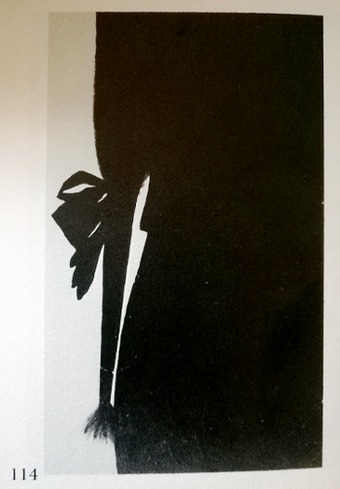
Typical bound pigtail wig of the 1790s. Detail from a silhouette, probably from the studio of John Miers at 111 Strand, London.
Author’s collection
Chapter 6
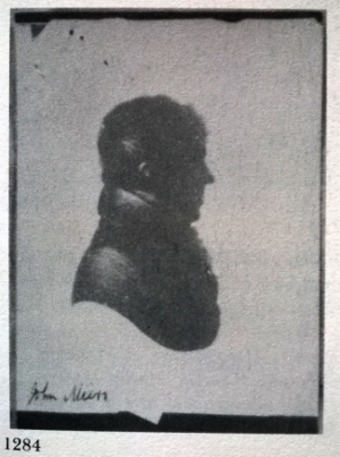
John Miers
Bronzed silhouette by John Field, probably painted on plaster, c. 1805, from a photograph given to the author by a descendant of the sitter.
Author’s collection
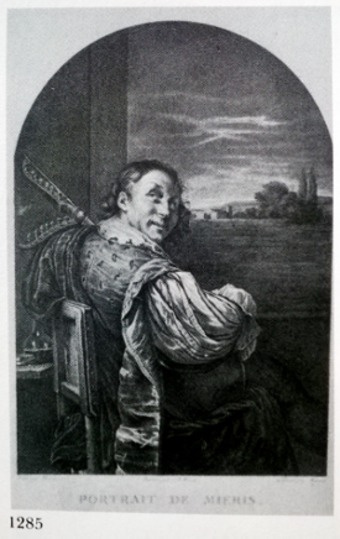
Francis Mieris (1635-81), possibly an ancestor of John Miers.
Engraving by Marais, from a drawing by J. B. Wicar, after a self-portrait by Mieris.
Author’s collection
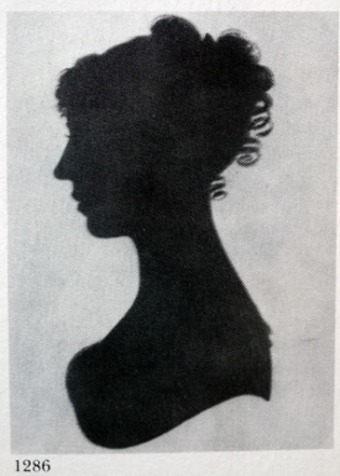
Sarah Miers (b. 1783), eldest daughter of John and Sarah Miers
Silhouette by John Field, painted
c. 1816
From L. Morgan May, ‘A Master of Silhouette’ (London, martin Secker, 1938), by courtesy of Mrs B. Morgan May
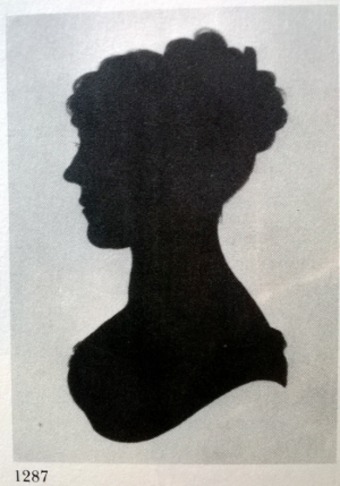
Mary Miers (1785-1840), second daughter of John and Sarah Miers
Silhouette by John Field, painted c. 1816
From L. Morgan May, ‘A Master of Silhouette’ (London, martin Secker, 1938), by courtesy of Mrs B. Morgan May
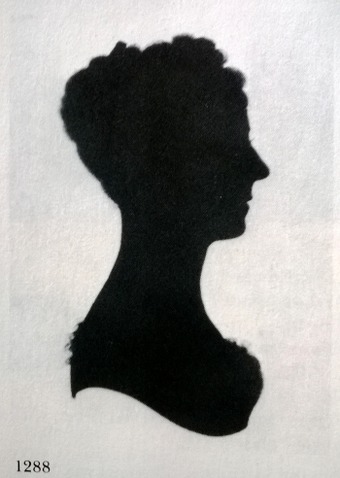
Eliza Miers (1786-1825), third daughter of John and Sarah Miers
Silhouette by John Field, painted c. 1816
From L. Morgan May, ‘A Master of Silhouette’ (London, martin Secker, 1938), by courtesy of Mrs B. Morgan May
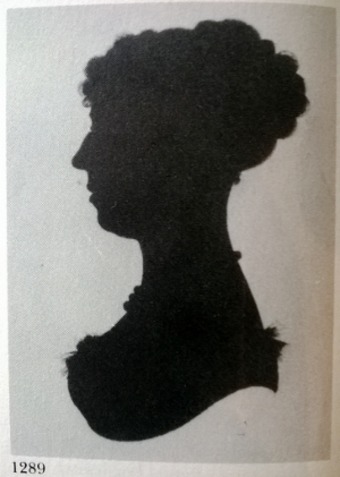
Harriet Miers (b. 1787), fourth daughter of John and Sarah Miers
Silhouette by John Field, painted c. 1816. (See 70 for another silhouette of this sitter by Field).
From L. Morgan May, ‘A Master of Silhouette’ (London, martin Secker, 1938), by courtesy of Mrs B. Morgan May
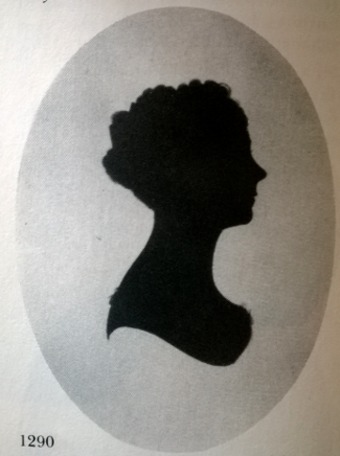
AnnaMiers (b. 1791), fifth daughter of John and Sarah Miers
Silhouette by John Field, painted c. 1816
From L. Morgan May, ‘A Master of Silhouette’ (London, martin Secker, 1938), by courtesy of Mrs B. Morgan May
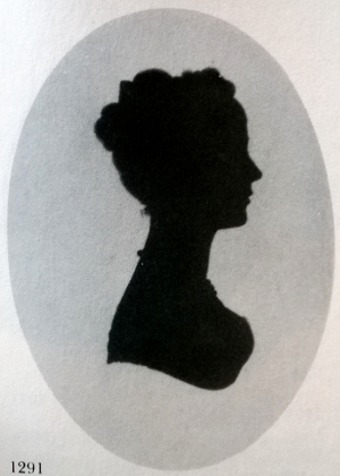
Caroline Miers (b. 1795), sixth daughter of John and Sarah Miers
Silhouette by John Field, painted c. 1816
From L. Morgan May, ‘A Master of Silhouette’ (London, martin Secker, 1938), by courtesy of Mrs B. Morgan May
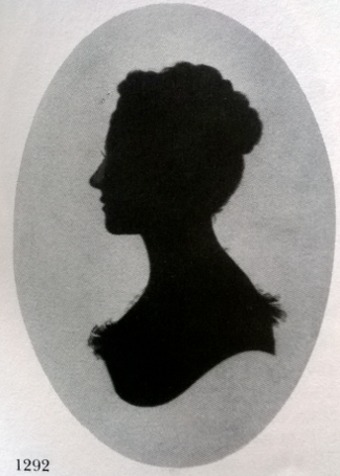
Sophia Rebecca Miers, seventh daughter of John and Sarah Miers
Silhouette by John Field, painted c. 1816
From L. Morgan May, ‘A Master of Silhouette’ (London, martin Secker, 1938), by courtesy of Mrs B. Morgan May

Mr Panther
Silhouette painted on plaster
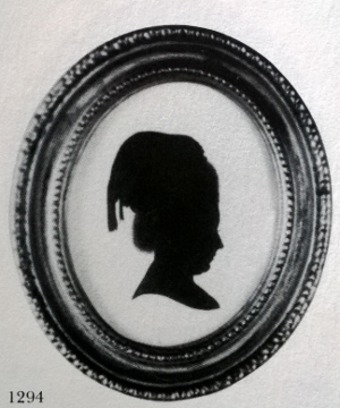
Unknown woman
Silhouette painted on plaster
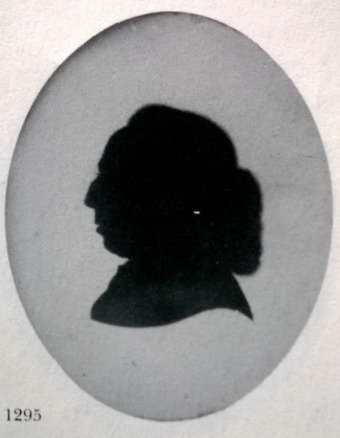
Mr Day
Silhouette painted on plaster
Late 1781
3 ½ x 2 ¾ in./90 x 70mm.
Trade Label No. 2
Painted in Leeds. Originally in a plaster frame.
Author’s collection
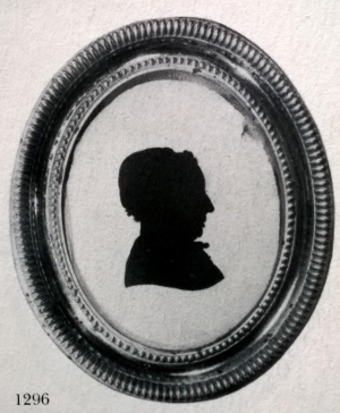
Mrs Day
Silhouette painted on plaster
Late 1781
3 ½ x 2 ¾ in./90 x 70mm.
Trade Label No. 2
Painted in Leeds. Originally in a plaster frame.
Author’s collection
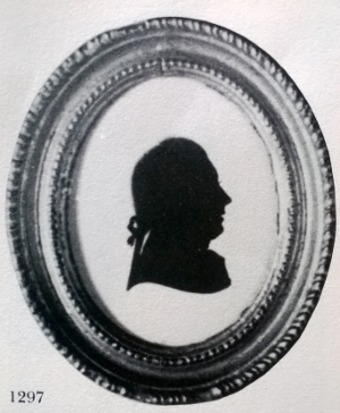
Unknown man
Silhouette painted on plaster
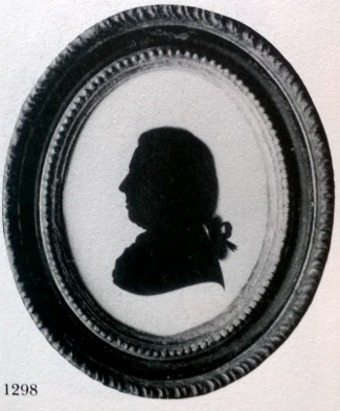
Unknown man
Silhouette painted on plaster
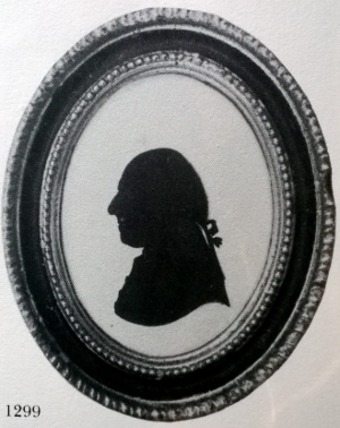
Unknown man
Silhouette painted on plaster
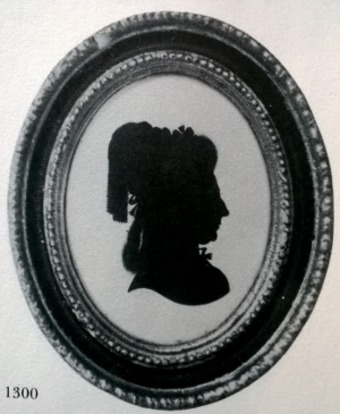
Unknown woman
Silhouette painted on plaster
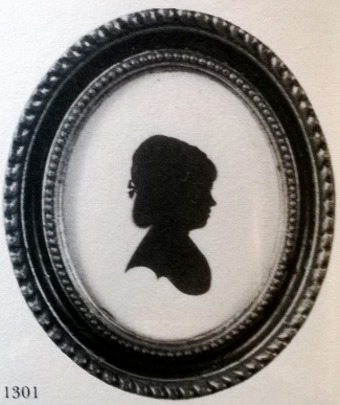
Unknown girl
Silhouette painted on plaster
c. 1783-84
3 ½ x 2 ¾ in./90 x 70mm.
Trade Label No. 5
Frame: plaster
M. A. H. Christie collection
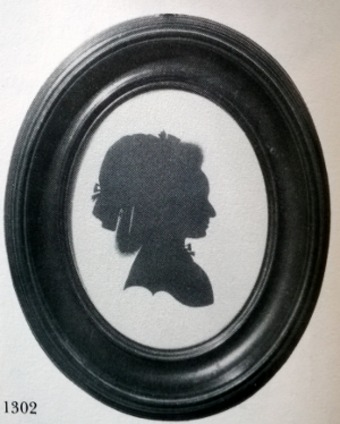
Unknown woman
Silhouette painted on plaster
c. 1783-84
3 ½ x 2 ¾ in./90 x 70mm.
Trade Label No. 5
Frame (possibly not original): pearwood
The bust-line is of the double-loop concavity type favoured by Miers for a short time while he was working in Leeds.
J. A. Pollak collection
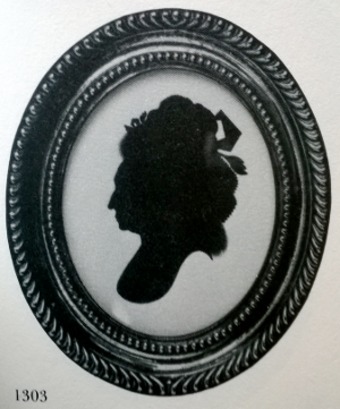
Unknown woman, a member of the Morgna family of Tredegar Park, Monmouth
Silhouette painted on plaster
? 1783-84
3 ¾ x 3in./96 x 77mm.
Trade Label No. 6
Frame: oval, hammered brass
The date is suggested by the style of painting.
T. R. Bruen collection
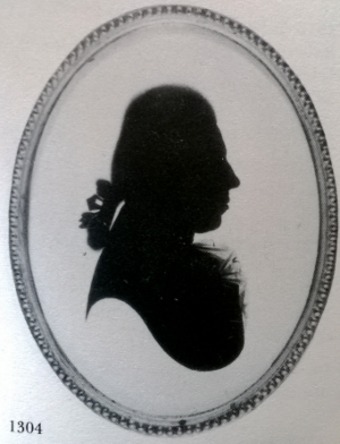
Unknown man
Silhouette painted on plaster
Early 1785
3 ½ x 2 ¾ in./90 x 70mm.
Trade Label No. 6
Frame: oval, hammered brass
By courtesy of Sotheby Parke Bernet and Company, London
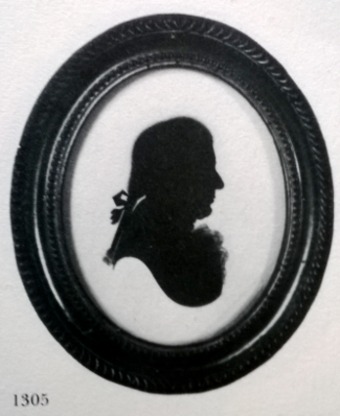
Unknown man
Silhouette painted on plaster
Early 1786
3 ½ x 2 ¾ in./90 x 70mm.
Trade Label No. 6
Frame: oval, hammered brass
M. A. H. Christie collection
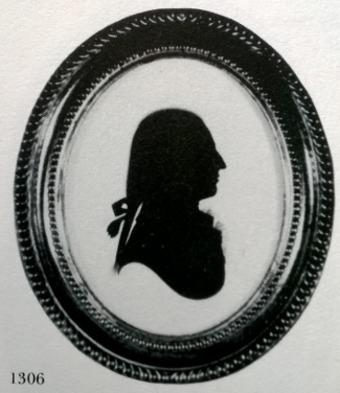
Unknown man
Silhouette painted on plaster
Late 1787
3 ½ x 2 ¾ in./90 x 70mm.
Trade Label No. 6
Frame: oval, hammered brass
The date is suggested by the style of painting. Miers was in Edinburgh at this period.
M. A. H. Christie collection
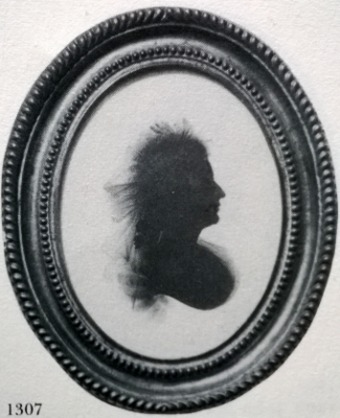
Unknown woman
Silhouette painted on plaster
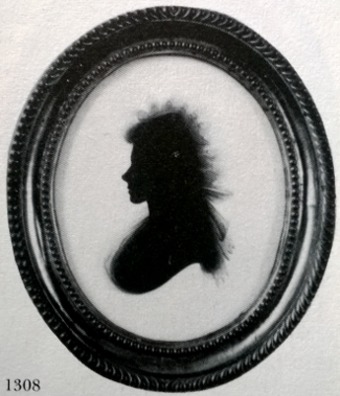
Unknown woman
Silhouette painted on plaster
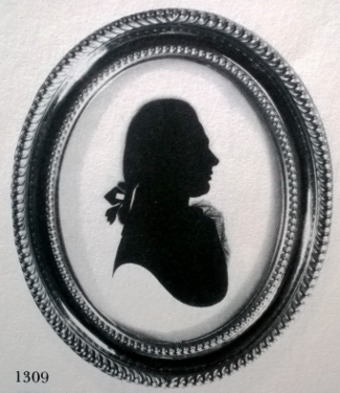
John Foxcroft
Silhouette painted on plaster
June 1785 – January 1786
3 ½ x 2 ¾ in./90 x 70mm.
Trade Label No. 7
Frame: oval, hammered brass
Painted in Liverpool.
By courtesy of R. F. Robertson-Glasgow
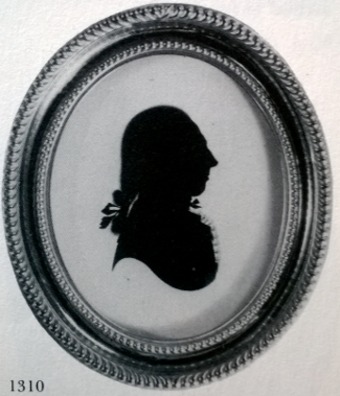
Thomas Foxcroft
Silhouette painted on plaster
June 1785 – January 1786
3 ½ x 2 ¾ in./90 x 70mm.
Trade Label No. 7
Frame: oval, hammered brass
Painted in Liverpool. The sitter may have been the brother of John Foxcroft (1309). Note the treatment of the frill, one of the methods typical of Miers at this date.
By courtesy of R. F. Robertson-Glasgow
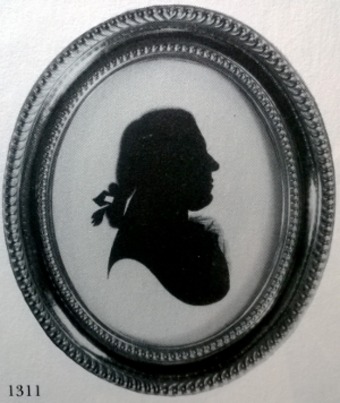
Felix Doran
Silhouette painted on plaster
June 1785 – January 1786
3 ½ x 2 ¾ in./90 x 70mm.
Trade Label No. 7
Frame: oval, hammered brass
Painted in Liverpool. The sitter was brother-in-law to John Foxcroft (1309).
By courtesy of R. F. Robertson-Glasgow
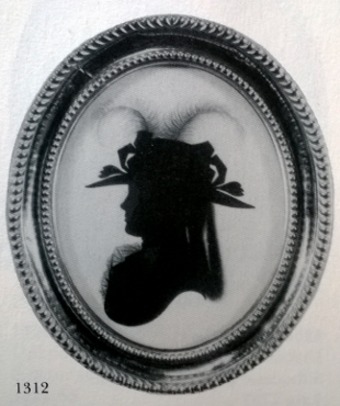
Mrs Mary E. Doran (née Foxcroft)
Silhouette painted on plaster
June 1785 – January 1786
3 ½ x 2 ¾ in./90 x 70mm.
Trade Label No. 7
Frame: oval, hammered brass
Painted in Liverpool. The sitter was the wife of Felix Doran (1311).
By courtesy of R. F. Robertson-Glasgow
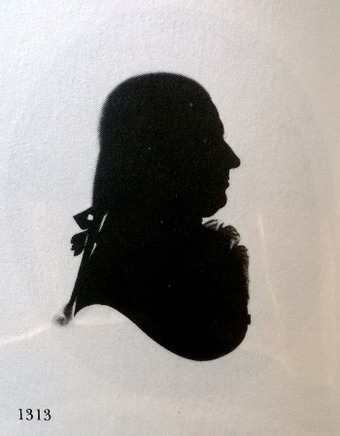
Robert Blair, Solicitor.General for Scotland
Silhouette painted on plaster
c. 1786
3 ½ x 2 ¾ in./90 x 70mm.
Trade Label No. 8
Frame: oval, hammered brass
Probably painted in Edinburgh. The sitter’s shirt.frill is rendered in a style transitional between that of Miers’s silhouettes known to have been painted in Liverpool and those illustrated in 1316-1317.
Crown Copyright. Victoria and Albert Museum, No. P. 154 1922
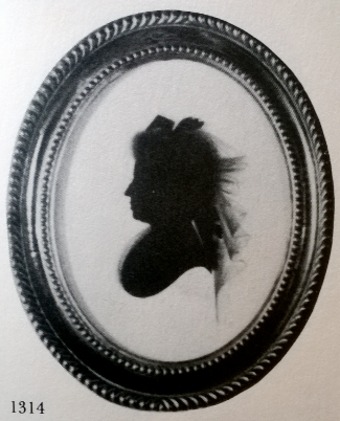
Unknown woman
Silhouette painted on plaster
Early 1787
3 ½ x 2 ¾ in./90 x 70mm.
Trade Label No. 8
Frame: oval, hammered brass
Probably painted in Edinburgh.
M. A. H. Christie collection
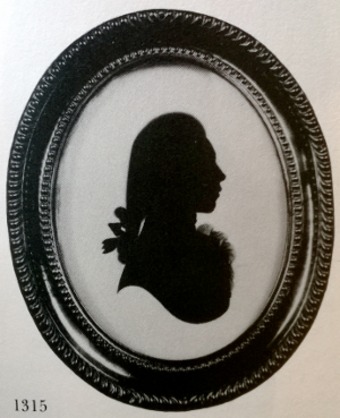
Crauford Tait
Silhouette painted
3 ½ x 2 ¾ in./90 x 70mm.
Trade Label No. 8
Inscribed ‘Edinburgh, 1787’ on the reverse. The sitter was a friend of Robert Burns. Miers’s treatment of shirt-frill was by now approaching the great skill shown in his London work.
T. R. Bruen collection
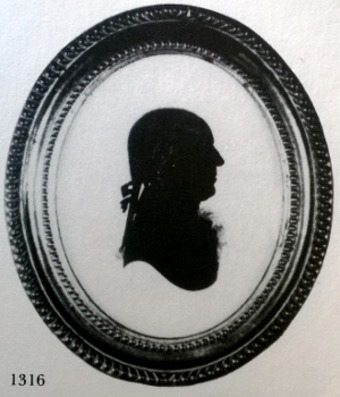
Unknown man
Silhouette painted on plaster
c. 1787
3 ½ x 2 ¾ in./90 x 70mm.
Trade Label No. 8
Frame: oval, hammered brass
M. A. H. Christie collection
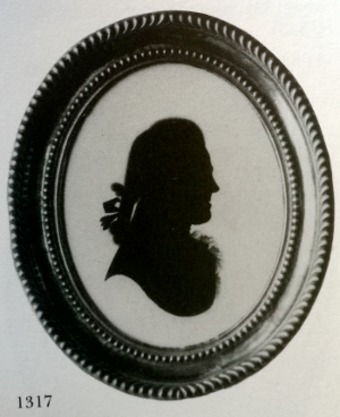
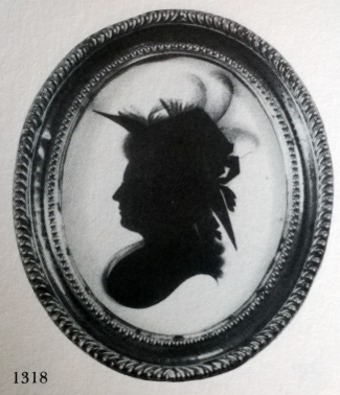
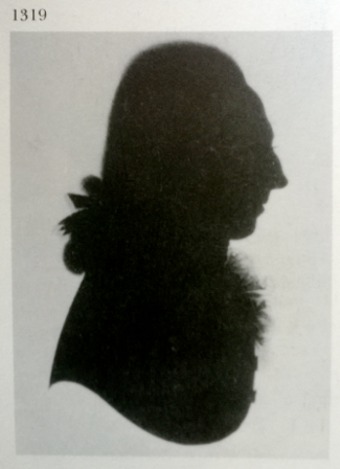
John Blackburne
Silhouette painted on plaster
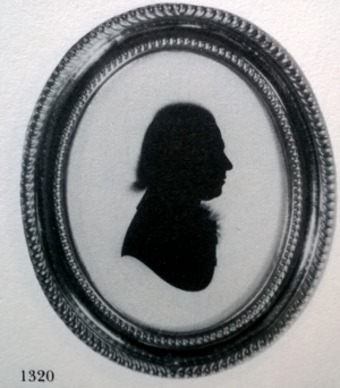
The Reverend T. H. Foxcroft
Silhouette painted on plaster
c. 1789
3 ½ x 2 ¾ in./90 x 70mm.
Trade Label No. 10
Frame: oval, hammered brass
The sitter is shown as an older man in 1342.
By courtesy of R. F. Robertson-Glasgow
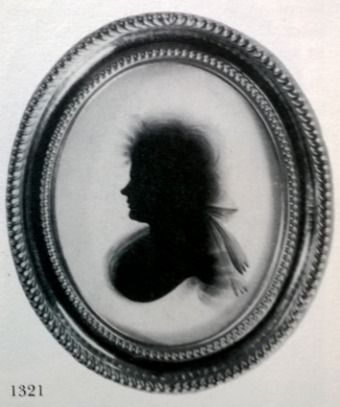
Agnes Foxcroft
Silhouette painted on plaster
c. 1789
3 ½ x 2 ¾ in./90 x 70mm.
Trade Label No. 10
Frame: oval, hammered brass
The sitter may have been the sister of the Reverend T. H. Foxcroft (1320).
By courtesy of R. F. Robertson-Glasgow

Eliza Foxcroft
Silhouette painted on plaster
c. 1789
3 ½ x 2 ¾ in./90 x 70mm.
Trade Label No. 10
Frame: oval, hammered brass
A typical example of Miers’s work at this period. Eliza Foxcroft may have been the sister of the subjects of 1320 and 1321. She married Robert Slade (1343).
By courtesy of R. F. Robertson-Glasgow
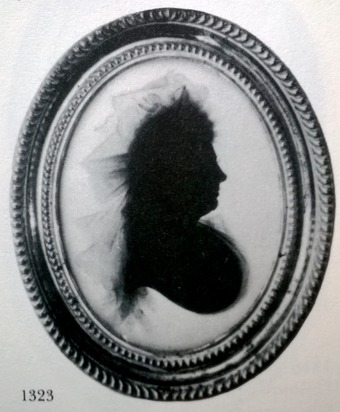
Unknown woman
Silhouette painted on plaster
c. 1789
3 ½ x 2 ¾ in./90 x 70mm.
Trade Label No. 10
Frame: oval, hammered brass
Author’s collection
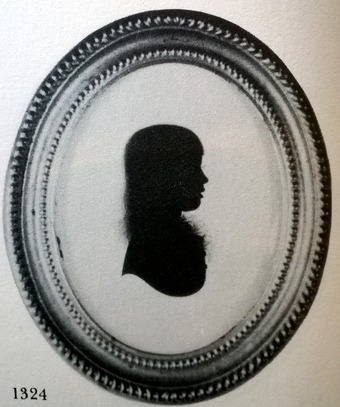
Unknown boy
Silhouette painted on plaster
c. 1789
3 ½ x 2 ¾ in./90 x 70mm.
Trade Label No. 10
Frame: oval, hammered brass
M. A. H. Christie collection

The Very Reverend George Stevenson, Dean of Killaloe and Kilfenora, Co. Clare
Silhouette painted on plaster
c. 1790
3 ½ x 2 5/8 in./90 x 67mm.
Trade Label No. 10
Frame: pearwood, with verre églomisé border
Author’s collection
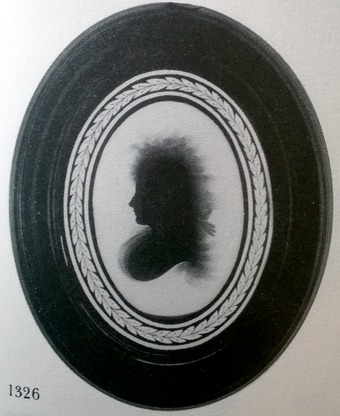
Mrs George Stevenson (née Lydia Thackeray)
Silhouette painted on plaster
c. 1790
3 ½ x 2 ½in./90 x 64mm.
Frame: pearwood, with verre églomisé border
Though unlabelled, this silhouette of the wife of the Dean of Killaloe and Kilfenora is obviously a pair to the silhouette of the Dean and of the same provenance. The treatment of the à la conseilleur hair-style is particularly fine.
Author’s collection

Nathaniel Edward Kindersley
Silhouette painted on plaster
c. 1791
3 ½ x 2 ¾ in./90 x 70mm.
Trade Label No. 10
Frame: pearwood, with verre églomisé border
From the collection of the late C. F. Sainsbury
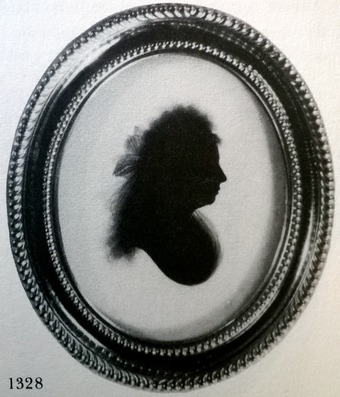
Jane Foxcroft
Silhouette painted on plaster
c. 1792
3 ½ x 2 ¾ in./90 x 70mm.
Trade Label No. 11
Frame: oval, hammered brass
An example of ‘X’ work from Miers’s studio. The sitter was the wife of the Reverend T. H. Foxcroft (1320).
By courtesy of R. F. Robertson-Glasgow
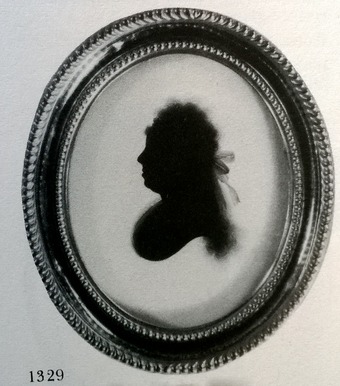
Mary Slade
Silhouette painted on plaster
c. 1792
3 ½ x 2 ¾ in./90 x 70mm.
Trade Label No. 11
Frame: oval, hammered brass
An example of ‘X’ work from Miers’s studio. The sitter, a relative of the Foxcroft family, married the Reverend T. H. Barrett.
By courtesy of R. F. Robertson-Glasgow
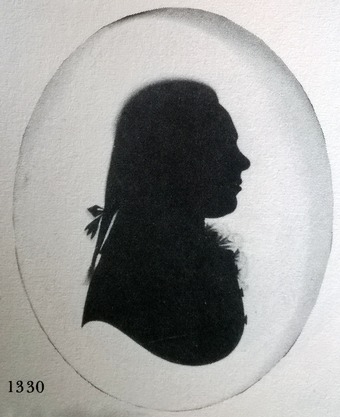
William Whateley
Silhouette painted on plaster
c. 1792
3 ½ x 2 ½in./90 x 64mm.
Trade Label No. 11
Frame: black pearwood
Undoubtedly painted by John Miers himself. Inscribed on the reverse, ‘William Whateley, Died July 14th, 1828.’ The sitter was an ancestor of many members of the Bagnall family.
Author’s collection
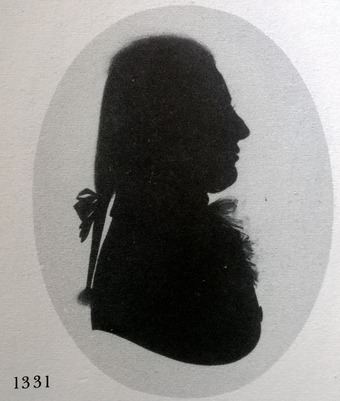
John Pearson the elder
Silhouette painted on plaster
c. 1792-93
3 ½ x 2 ½in./90 x 64mm.
Trade Label No. 11
Frame: pearwood
An example of ‘X’ work from Miers’s studio.
Author’s collection
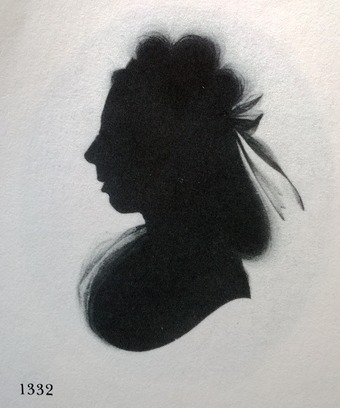
Mrs John Pearson
Silhouette painted on plaster
c. 1792-93
3 ½ x 2 ½in./90 x 64mm.
Trade Label No. 11
Frame: pearwood
An example of ‘X’ work from Miers’s studio and a pair to the silhouette of the sitter’s husband (1331).
Author’s collection
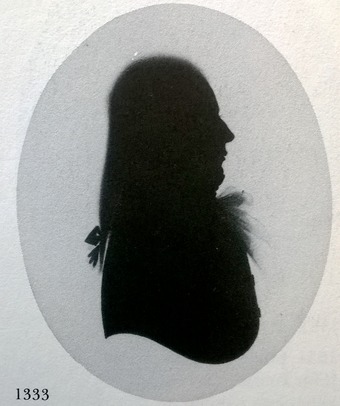
Unknown man
Silhouette painted on plaster
c. 1794
3 ½ x 2 ½in./90 x 64mm.
Trade Label No. 11
Frame: pearwood, with verre églomisé border
Almost certainly painted by John Field.
By courtesy of Sotheby Parke Bernet and Company, London

Charles Smith
Silhouette painted on plaster
c. 1794-95
3 ½ x 2 ½in./90 x 64mm.
Trade Label No. 11
Frame: oval, black pearwood, with convex glass
Painted by John Field, who also painted the sitter’s father (113) at Miers’s studio.
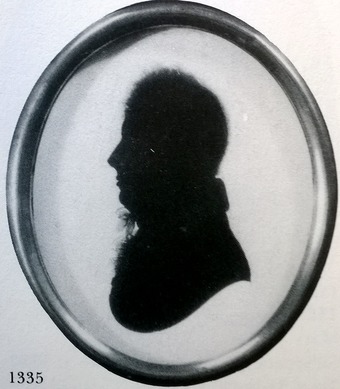
Unknown man
Silhouette painted on plaster
Early 1800s
Trade Label No. 11
Painted by John Field. The plaster slab has been cut to fit the frame, which is not original.

George Kenyon
Silhouette painted on plaster
c. 1810
3 ¼ x 2 ¼in./83 x 58mm.
Trade Label No. 12
Frame: papier mâché, with ormolu furniture and inner surround
Painted by John Field.
M. A. H. Christie collection
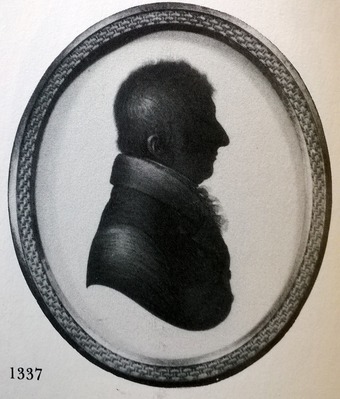
Unknown man
Silhouette painted on plaster, bronzed
c. 1810-12
3 ¼ x 2 ¼in./83 x 58mm.
Trade Label No. 12
Frame: papier mâché, with ormolu furniture
Painted by John Field.
Author’s collection
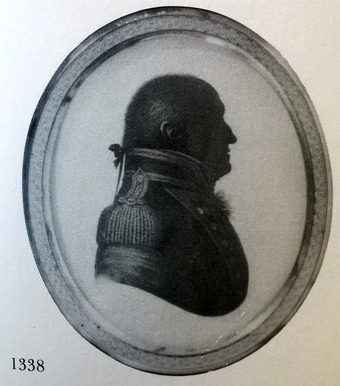
Admiral Sir Benjamin Hallowell-Carew
Silhouette painted on plaster, bronzed
c. 1812
3 ¼ x 2 ¼in./90 x 58mm.
Trade Label No. 12
Frame: papier mâché, with ormolu surround and hanger representing a shell, rope and anchor
Painted by John Field. There is also a profile of this sitter by Hinton Gibbs (1530).
Author’s collection
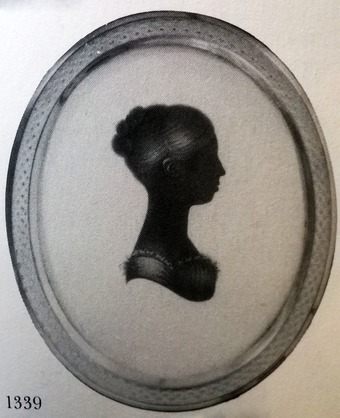
Mrs T. W. Bottomley (née Sarah King)
Silhouette painted on plaster, bronzed
c. 1812-15
3 ¼ x 2 ¼in./83 x 58mm.
Trade Label No. 12
Frame: papier mâché, with ormolu furniture
Painted by John Field.
Author’s collection
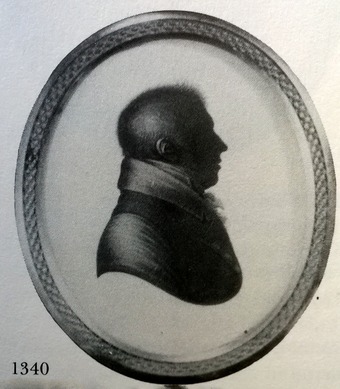
Unknown man
Silhouette painted on plaster, bronzed
c. 1812-16
3 ¼ x 2 ¼in./83 x 58mm.
Trade Label No. 12
Frame: papier mâché, with ormolu furniture
Painted by John Field.
T. E. F. Sainsbury collection
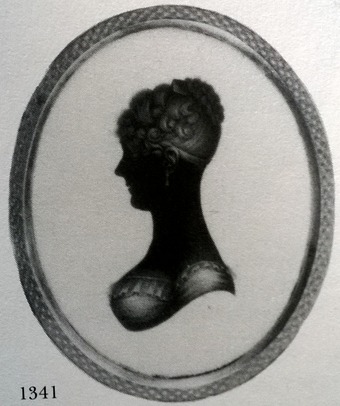
Unknown woman
Silhouette painted on plaster, bronzed
c. 1816-19
3 x 2 ¼in./77 x 58mm.
Trade Label No. 12
Frame: papier mâché, with ormolu furniture
Painted by John Field.
By courtesy of Sotheby Parke Bernet and Company, London
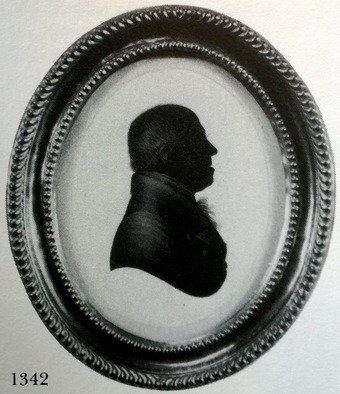
The Reverend T. H. Foxcroft
Silhouette painted on plaster, bronzed
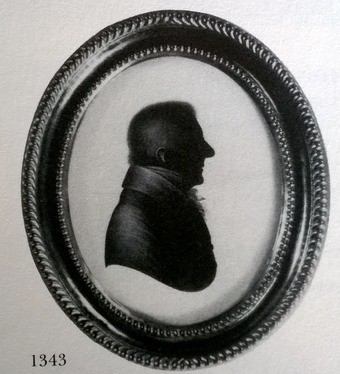
Robert Slade
Silhouette painted on plaster, bronzed
? 1819
3 ½ x 2 ¼in./90 x 58mm.
Trade Label No. 12
Painted by John Field. The sitter married Eliza Foxcroft (1322). Like the example shown in 1342, this silhouette has been reframed to conform with earlier silhouettes of members of the Foxcroft family.
By courtesy of R. F: Robertson-Glasgow
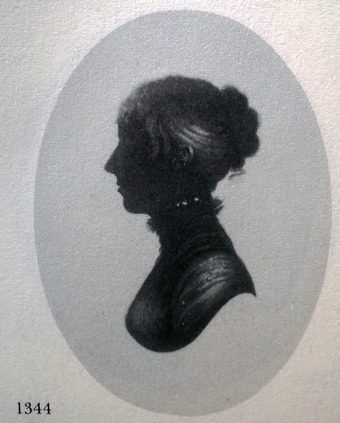
Mrs Howell
Silhouette painted on plaster, bronzed
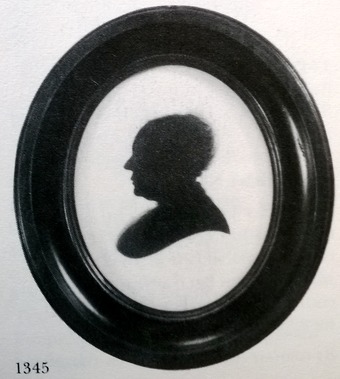
Unknown woman
Silhouette painted on plaster, bronzed
? c. 1815
3 3/8 x 2 ½ in./86 x 64mm.
Trade Label No. 12
Frame: oval, turned wood
Painted by John Field.
James Cartland collection
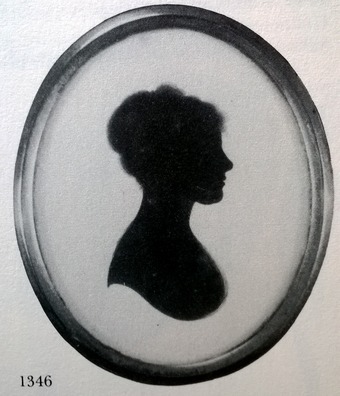
Unknown woman
Silhouette painted on plaster, bronzed
c. 1816-20
3 ½ x 2 ½ in./90 x 64mm.
Trade Label No. 12
Frame: papier mâché, with brass surround and ‘emblems’ hanger
Painted by John Field.
Private collection
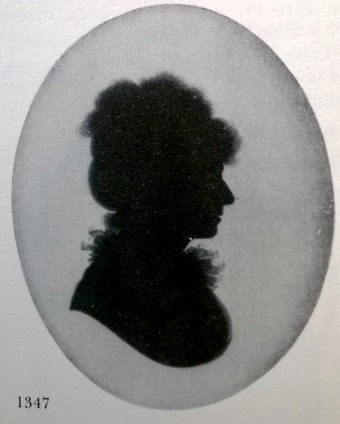
Elizabeth, Countess of Hardwicke
Silhouette painted on plaster
c. 1818-20
3 ¼ x 2 ¼ in./83 x 58mm.
Trade Label No. 12
Frame: oval, pearwood
Painted by John Field. The Countess was the daughter of James, the fifth Earl of Balcarres. She married Philip Yorke, the third Earl of Hardwicke, in 1782.
From L. Morgan May, ‘A Master of Silhouette’ (London, Martin Secker, 1938), by courtesy of Mrs B. Morgan May
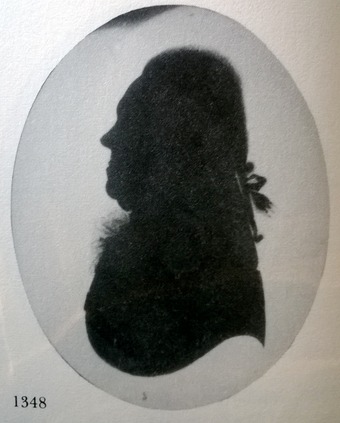
Unknown man
Silhouette painted on plaster
3 ¼ x 2 ¼ in./83 x 58mm.
Trade Label No. 12
Frame: oval, turned pearwood
Apparently a copy by Miers of an earlier silhouette painted by himself; the frame is much smaller than was customary before 1800.
James Cartland collection
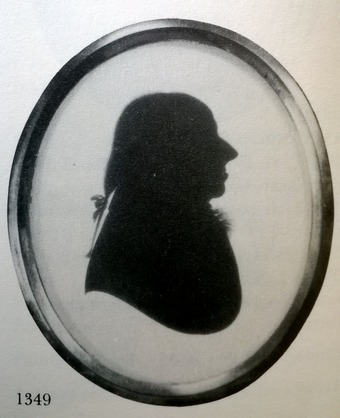
James Louis Turquand
Silhouette painted on plaster
3 ¾ x 2 ¾ in./96 x 70mm.
Trade Label No. 12
Frame: papier mâché, with brass surround and ormolu leaf hanger
Probably a copy by John Field of an earlier silhouette by John Miers. There is also a silhouette of this sitter by Henry G. Vigne (941).
James Cartland collection
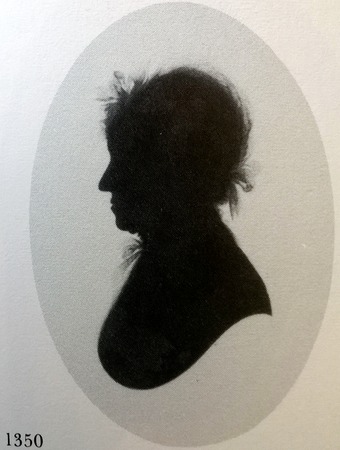
Mrs William Watson (née Beilby)
Silhouette painted on plaste
3 ¼ x 2 ½ in./83 x 64mm.
Trade Label No. 13
Frame: papier mâché, with pearwood oval and verre églomisé border
A copy by John Field of an earlier silhouette by John Miers.
From the collection of the late c. F. Sainsbury
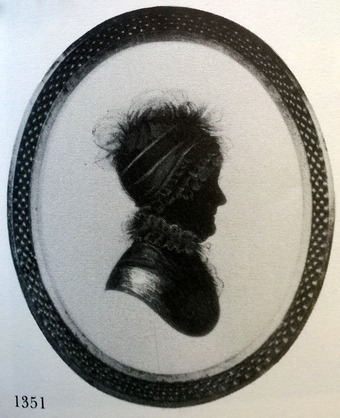
Unknown woman
Silhouette painted on plaster, bronzed
c. 1821-1822
3 ¼ x 2¼in./83 x 58mm.
Frame: papier mâché, with ormolu furniture
This silhouette, painted by John Field, is known to have borne either Trade Label No. 13 or Trade Label No. 14.
From L. Morgan May, ‘A Master of Silhouette’ (London, Martin Secker, 1938), by courtesy of Mrs B. Morgan May
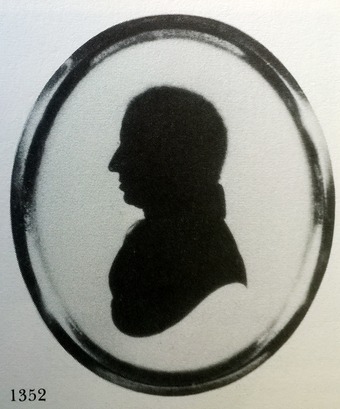
Unknown man
Silhouette painted on plaster
Late 1821-1822
3¼ x 2 ½ in./83 x 64mm.
Frame: papier mâché, with brass surround
This silhouette, painted by John Field, is known to have borne either Trade Label No. 13 or Trade Label No. 14.
From L. Morgan May, ‘A Master of Silhouette’ (London, Martin Secker, 1938), by courtesy of Mrs B. Morgan May
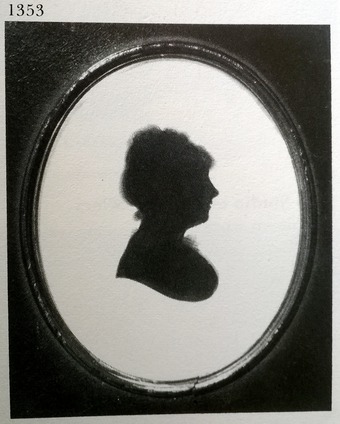
Mrs Bevan
Silhouette painted on plaster
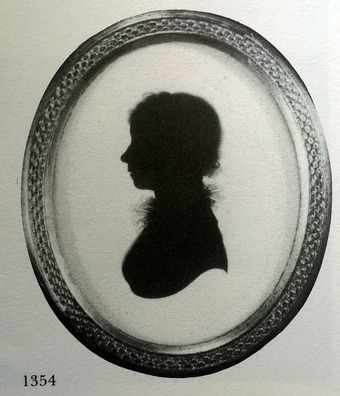
Unknown girl
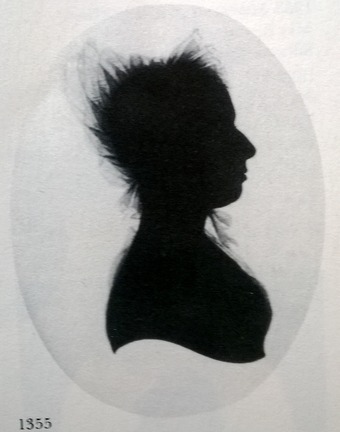
Unknown woman
Silhouette painted on plaster
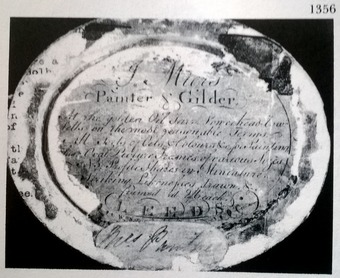
Trade Label No. 1 (‘Oil tarr 2s 6d’) of John Miers, from the silhouette shown in 1293.
J. A. Pollak collection
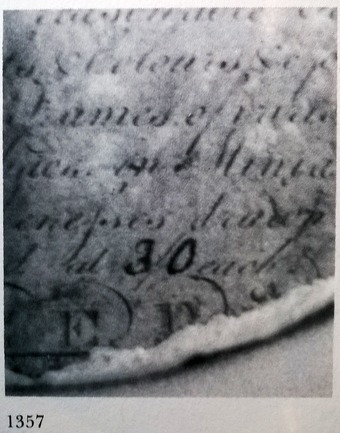
Detail from Trade Label No. 2 (‘Oil tarr 3s inked in’) of John Miers, form the silhouette shown in 1295.
Author’s collection
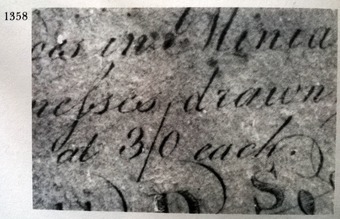
Detail from Trade Label No. 3 (‘Oil tarr 3s’) of John Miers, form the silhouette shown in 1298.
T. E. F. Sainsbury collection
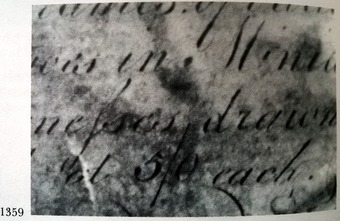
Detail from Trade Label No. 4 (‘Oil tarr 5s’) of John Miers, form the silhouette shown in 1299.
Author’s collection
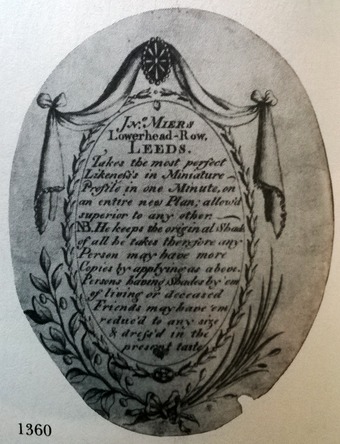
Trade Label No. 5 (‘Lowerhead Row’) of John Miers, from the silhouette shown in 1302.
J. A. Pollak collection
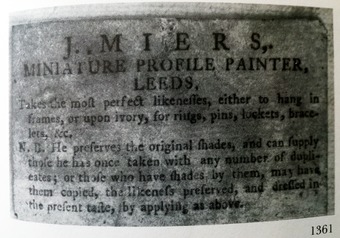
Trade Label No. 6 (‘Small Leeds’) of John Miers, from the silhouette shown in 1305.
M. A. H. Christie collection
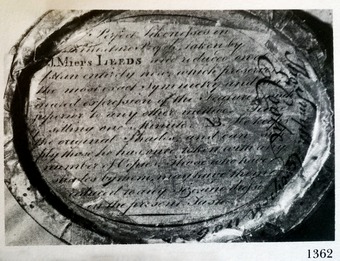
Trade Label No. 7 (‘Liverpool’) of John Miers. This example of the label is inscribed, ‘Thos. Smith, Liverpool, 1786, E. Cooke.’
Mrs Peggy Hickman collection
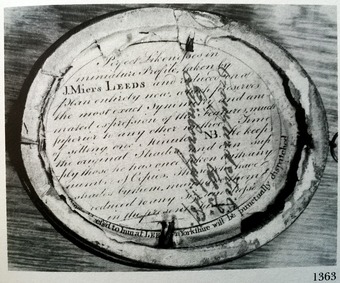
Trade Label No. 8 (‘Travelling’) of John Miers. This example is inscribed, ‘Crauford Tait. W. S. Edinborough, 1787.’
T. R. Bruen collection
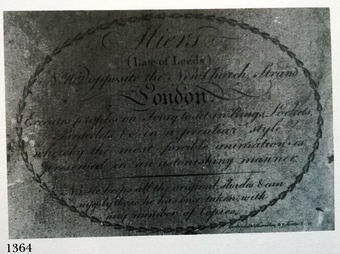
Trade Label No. 10 (‘162 Strand’) of John Miers.
Author’s collection
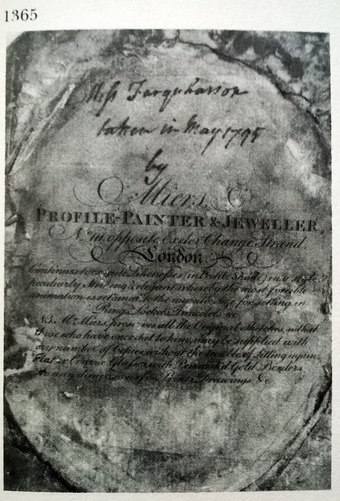
Trade Label No. 11 (‘Burnished gold’) of John Miers.
Author’s collection
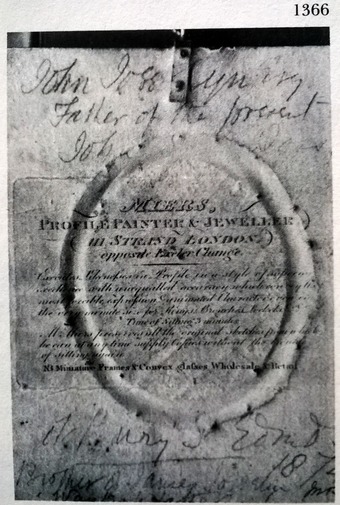
Trade Label No. 12 (‘Double-letter’) of John Miers.
D. S. Patton collection
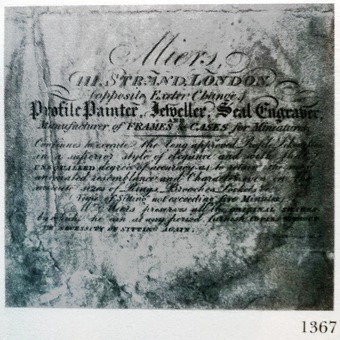
Trade Label No. 13 (‘Seal-engraver 1’), used by William Miers. From the silhouette shown in 1350.
From the collection of the late C. F. Sainsbury
1368
Trade Label No. 14 (‘Seal-engraver 2’), used by William Miers. From the silhouette shown in 1354.
Author’s collection
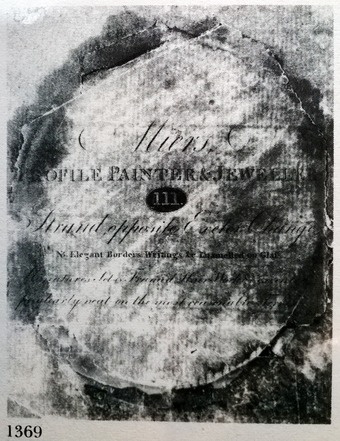
Trade Label No. 15 (‘Framer’s’), used by William Miers.
Author’s collection
1370
Trade Label No. 17 (‘111 Strand jewel 1’) of John Miers (for jewellery work).
Jean Lapworth collection
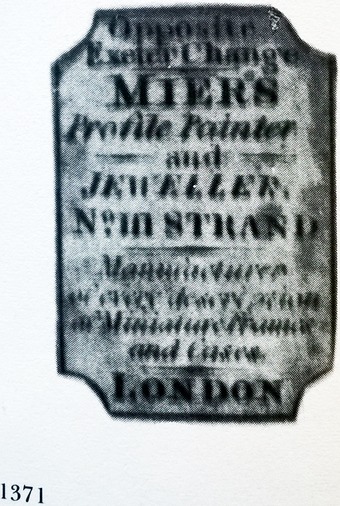
Trade Label No. 18 (‘111 Strand jewel 2’) of John Miers. Intended for jewellery work, although this example is on the reverse of a silhouette (1355) painted on plaster.
R. Kilner collection
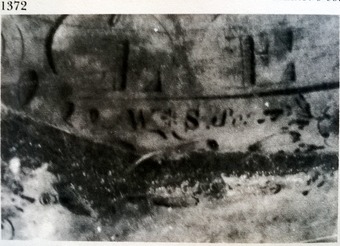
Detail (enlarged) from a trade label of John Miers, showing the initials of the printer of Trade Labels Nos 1-4.
Author’s collection
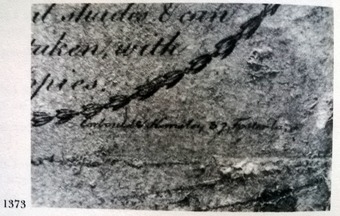
Detail (enlarged) from Trade Label No. 10 of John Miers, showing the name and address of the printer.
From the collection of the late C. F. Sainsbury
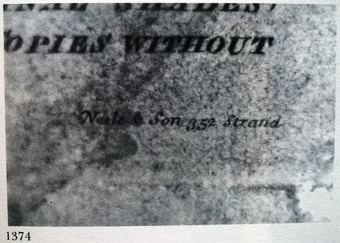
Detail (enlarged) from a trade label of John Miers, showing the name and address of the printer of Trade Labels Nos 13 and 14.
From the collection of the late C. F. Sainsbury
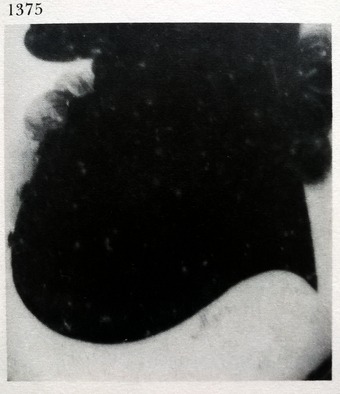
Signature of John Miers, from a silhouette (1497; framed in a locket/brooch) undoubtedly painted by Miers himself, probably at 162 Strand, 1788-89. The name Miers is written well away from the sharply pointed back of the bust-line termination, and the formation of the ‘r’ is typical of Miers’s own hand. The shadows below the sitter’s pigtail ribbons are also typical of Miers’s work.
Author’s collection
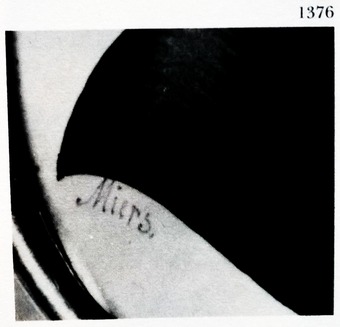
The form of signature seen on most silhouettes in jewellery setting painted at the studio of John Miers; both silhouette (1501) and signature are from the hand of John Field. This signature is placed nearer the back of the bust-line termination than the signature by Miers himself illustrated in 1375, and the ‘r’ is differently formed.
Author’s collection
Detail
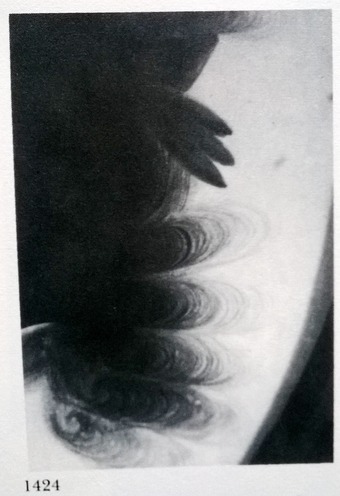
The à la conseilleur hair-style. This detail from a silhouette of a woman by John Miers, painted at 162 Strand, London, shows Miers’s technique at its finest. Note the manner in which the lowest of the sitter’s curls is painted, and the rendering of the bandeau which was worn with this hair-style. (1326)
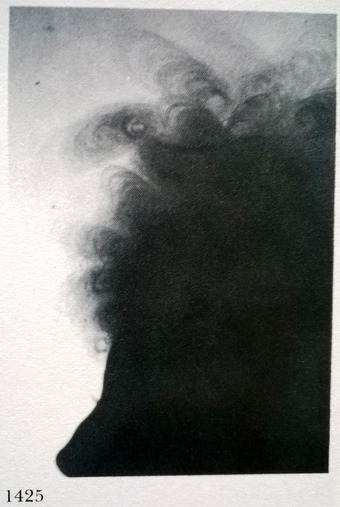
Front hair of a woman. Detail from a silhouette by John Miers, painted at 162 Strand, London. The fine precision of the painting, and the individual treatment of one of the sitter’s curls (in this case, that on the far left), are alike typical of the artist’s style. (1326)
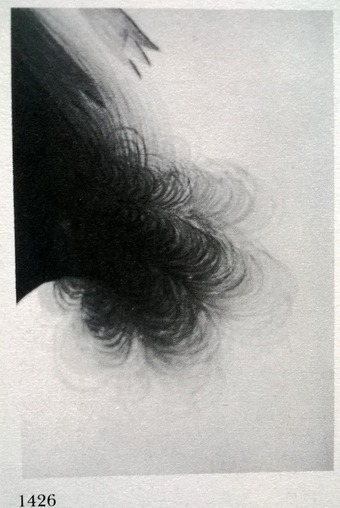
The à la conseilleur hair-style. Detail from a silhouette of a woman painted at the studio of John Miers at 111 Strand, London (‘X’ work). (1329)
Note the light treatment of the ribbons, and the swirling style in which this hair-style is rendered, compared with Miers’s own manner (1424).
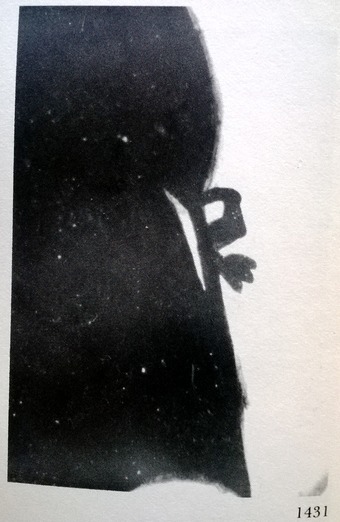
Pigtail wig. Detail from a silhouette by John Miers, painted in Leeds during the artist’s early period and bearing Trade Label No. 4 (1299)
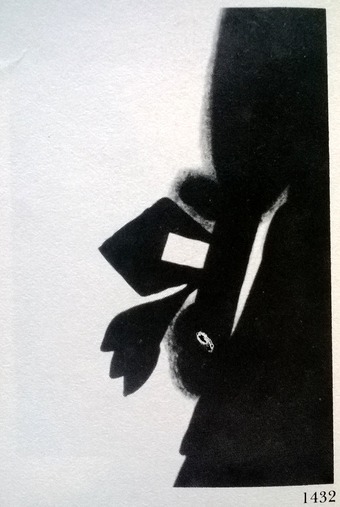
‘Catogan’ wig. Detail from a silhouette of a man (John Foxcroft) by John Miers, painted during the artist’s middle period and bearing. Trade Label No. 7. The large rhomboid inside the arrow-shaped bow is typical. (1309)
By courtesy of R. F. Robertson-Glasgow
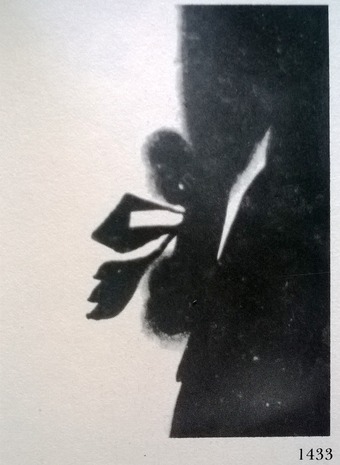
‘Catogan’ wig. Detail from a silhouette of a man (John Foxcroft) by John Miers, painted during the artist’s middle period and bearing. Trade Label No. 2. (1310)
By courtesy of R. F. Robertson-Glasgow

Pigtail wig. Detail from a silhouette of a man by John Miers, painted at 162 Strand, London, during the artist’s later period. The rhomboid inside the bow is now smaller and thinner than before, and shadows have been added to give a three dimensional effect. In my view, these shadows are sufficient to indicate the hand of Miers himself of any silhouette bearing one of his London trade labels. (1327)
From the collection of the late C. F. Sainsbury
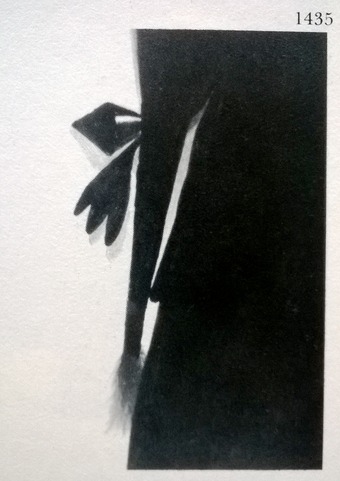
Pigtail wig. Detail from a silhouette of a man by John Miers, painted at 111 Strand, London, during the artist’s later period. The shadows below the ribbons, and the formation of the bow, indicate Miers’s hand. (1330)
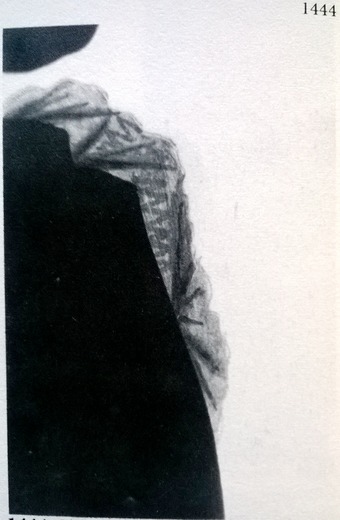
Shirt-frill. Detail from a silhouette of a man (John Foxcroft) by John Miers, painted in Liverpool June 1785-January 1786. At this time, Miers painted the frills on women’s dresses in the same manner. (1309)
By courtesy of R. F. Robertson-Glasgow

Shirt-frill. Detail from a silhouette of a man (Thomas Foxcroft) by John Miers, painted in Liverpool June 1785-January 1786, showing a style of rendering a shirt-frill which Miers occasionally employed at this period. (1310)
By courtesy of R. F. Robertson-Glasgow
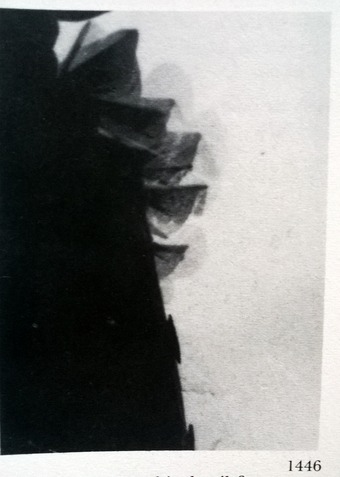
Shirt-frill. This detail from a silhouette of a man painted at the studio of John Miers at 111 Strand, London, c. 1791-93 (‘X’ work), shows a style frequently used, both for silhouettes on plaster and for silhouettes on ivory, at Miers’s studio during this period.
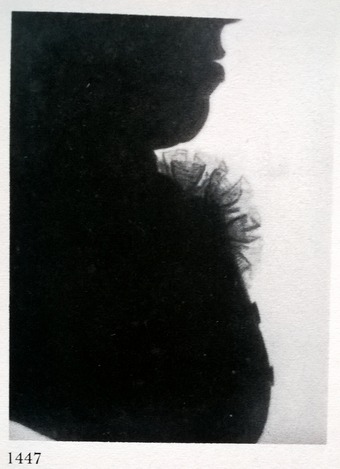
Frill on collar. Detail from a silhouette of a boy, painted at the studio of John Miers at 111 Strand, London, in 1795. The horizontal hatching in the more transparent parts of the frill suggests the hand of John Field. (235)
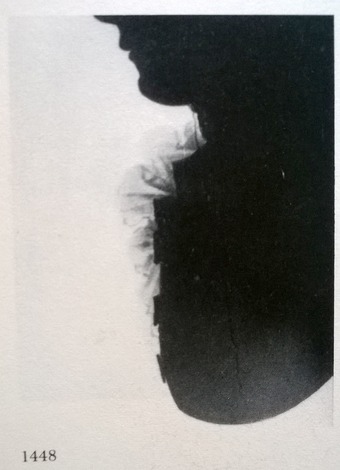
Shirt-frill. Detail from a silhouette of a man by John Miers, painted at 162 Strand, London. This style can be seen on all silhouettes bearing Miers’s Trade Label No. 10, and on some, painted at his studio after 1791, bearing Trade Label No. 11. (1327)
From the collection of the late C. F. Sainsbury
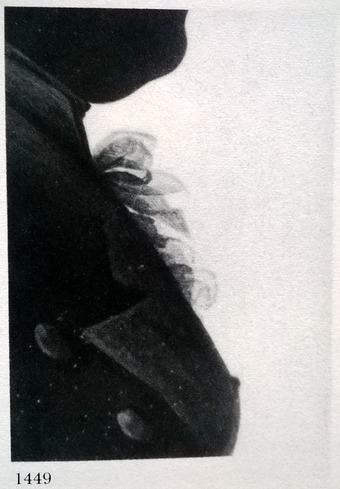
Shirt-frill. Detail from a silhouette of a man (the Reverend T. H. Foxcroft) painted (undoubtedly by John Field) at the studio of John Miers at 111 Strand, London, bearing Trade Label No. 12. (1342)
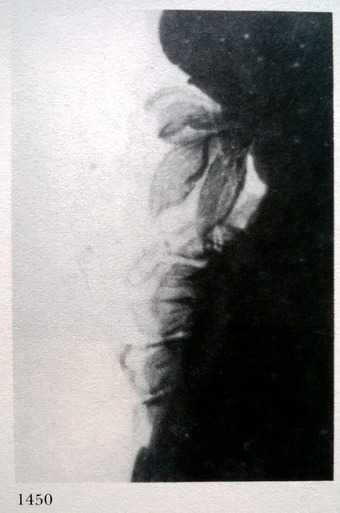
Shirt-frill. Detail from a silhouette of a man painted (undoubtedly by John Field) at the studio of John Miers at 111 Strand, London, after 1800, bearing Trade Label No. 11. (1335)
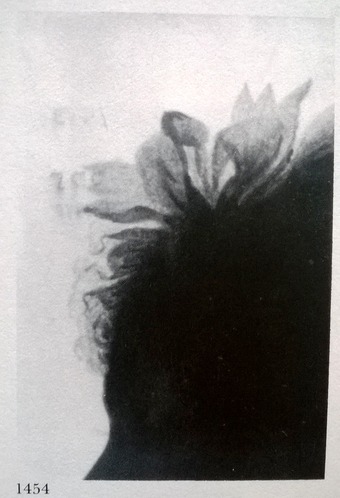
Bow of a woman’s cap. Detail from a silhouette painted by John Field at the studio of William Miers, 111 Strand, London, bearing Trade Label No. 13. (1350)
From the collection of the late C. F. Sainsbury
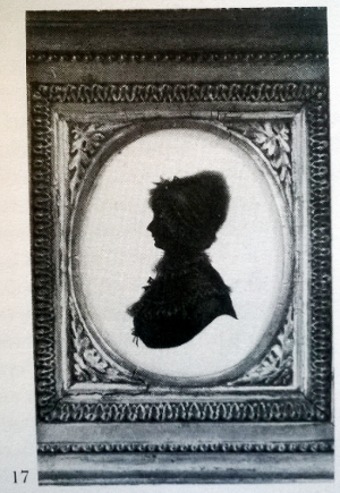
3 ½ x 2 ¾ in./90 x 70mm.
Trade Label No. 10
Frame: pearwood
Inscribed, ‘my brother John Blackburne of Hawford Lodge, Worcestershire, Mayor of Liverpool, 1788, J. P., M.A.’
From L. Morgan May, ‘A Master of Silhouette’ (London, Martin Secker, 1938), by courtesy of Mrs B. Morgan May
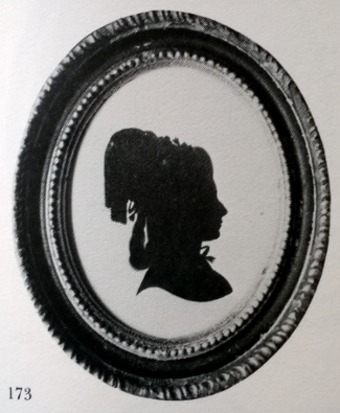
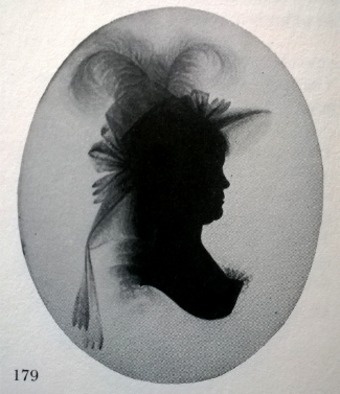
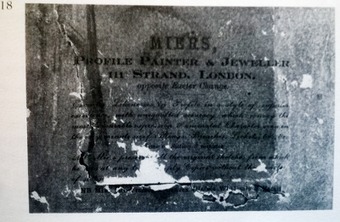
3 ½ x 2 ½ in./90 x 64mm.
Trade Label No. 18
Frame: oval, turned wood
Painted by John Field. Trade Label No. 18 (intended for jewellery work) may have been used in place of either Nos 13 or 14, if stocks of these had been exhausted. The frame (of a type no longer fashionable at this date) was presumably taken from old stock.
R. Kilner collection
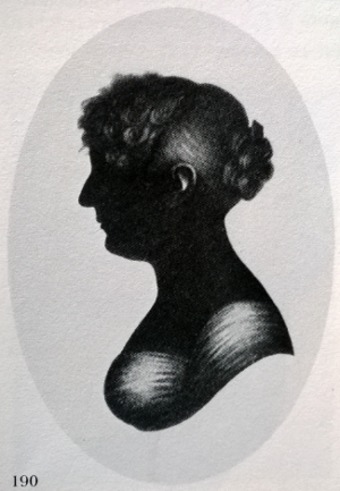
Unknown woman
Silhouette by John Miers, probably 1800-1802.
costume dating points
The first of the four hair-styles described in the text under ‘1800-1820’, complete with comb (smaller that the comb worn in later years).
The dress, with its low, square décolletage, worn without a fill-in.
From E. Nevill Jackson, ‘The Histroy of Silhouettes’ (1911), by courtesy of the ‘Connoisseur’
Chapter 8
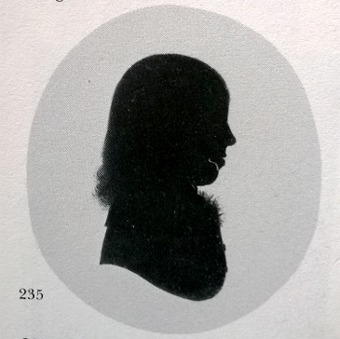
Master Farquharson (aged about twelve)
Silhouette by John Field, at the studio of John Miers, May 1795. (See 246 for a silhouette of Master Farquarson’s sister).
costume dating points
The length of the hair, which, for a boy of this age, was still long at this date.
The ridge at the back of the profile, below the hair, suggests that the boy is wearing a frock. There would be no such indication at the back of the frilled collar worn with a skeleton suit.
The positions of the shirt-frill and buttons are as they would be on a man’s costume at this period.
Author’s collection
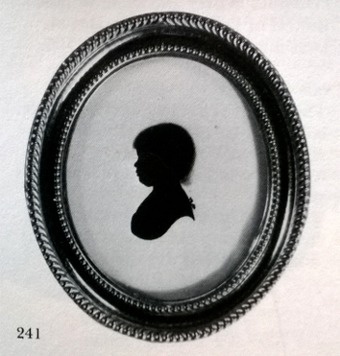
Bell Doran, a younger sister of M. E. Doran (242)
Silhouette by John Miers, c. 1785, taken when Bell was aged about eighteen months.
costume dating points
Thought Bell is still little more than a baby, there are signs of her hair being permitted to grow until it will reach the fashionable length for a small girl. The dress is of the same type as her sister’s.
By courtesy of R. F. Robertson-Glasgow
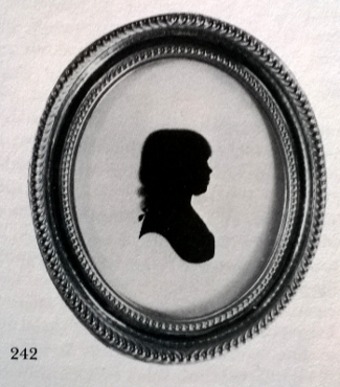
M. E. Doran, sister of Edward Doran (234), and Bell (241), daughter of Felix and Mary E. Doran (née Foxcroft). Born 1782. Silhouette by John Miers, c. 1785.
costume dating points
This small girl is growing her hair to what will be the fashionable length, and she already has the fringe which would shortly be expected.
The dress is of the type with the cord round the neck which was let out as the child grew; the bow is clearly visible at the back.
By courtesy of R. F. Robertson-Glasgow
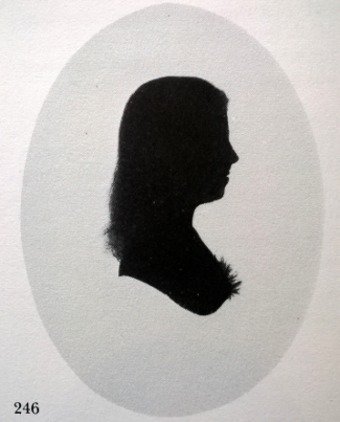
Miss Farquharson (aged about fourteen)
Silhouette by John Filed, at the studio of John Miers, May, 1795.
The length of the hair should be compared with that of the sitter’s brother, shown in a silhouette taken at the same time (235).
Since, however, this silhouette of Miss Farquharson differs little in its basic outline from that of Elizabeth Steuart (240), taken twelve years earlier, we can thus see the difficulty inherent in dating late eighteenth-century silhouettes of children.
Author’s collection
SECTION FOUR
